History of Nova Scotia
with special attention given to
Communications and Transportation
Chapter 9
1 January 1850 to 31 December 1859
Index with links to the other chapters
1850 January
The Telegraph War
November 1849 - January 1850
The Electric Telegraph Lines
Between New York and Halifax
In 1852, Alexander Jones wrote:
"The war was a very fierce one; many phamphlets appeared on both sides, including one by Mr. Craig in his defence against Smith's charges." The publication Jones referred to, "including one by Mr. Craig in his defence," was a 29-page printed phamphlet, part of which is reproduced below.
[The quote is from page 140, Historical Sketch of the Electric Telegraph, by Alexander Jones, 1852, published by George E. Putnam, New York.]
And who was Alexander Jones?
Dr. Alexander Jones, a graduate in medicine whose early interest in communications had lured him into journalism, became the first general manager of the newly-formed New York Associated Press. Jones opened a simple office at the top of a long, dim flight of stairs at the northwest corner of Broadway and Liberty Street, in New York. This served as the headquarters of The Associated Press for more than two decades. At first the entire New York staff consisted of Jones and one assistant. Jones gave The Associated Press all his energy and ability, but was seriously overworked and submitted his resignation on May 19, 1851. Jones' replacement as general manager was Daniel H. Craig.
[Excerpted from The Associated Press: The Story of News, by Oliver Gramling, 1940]
|
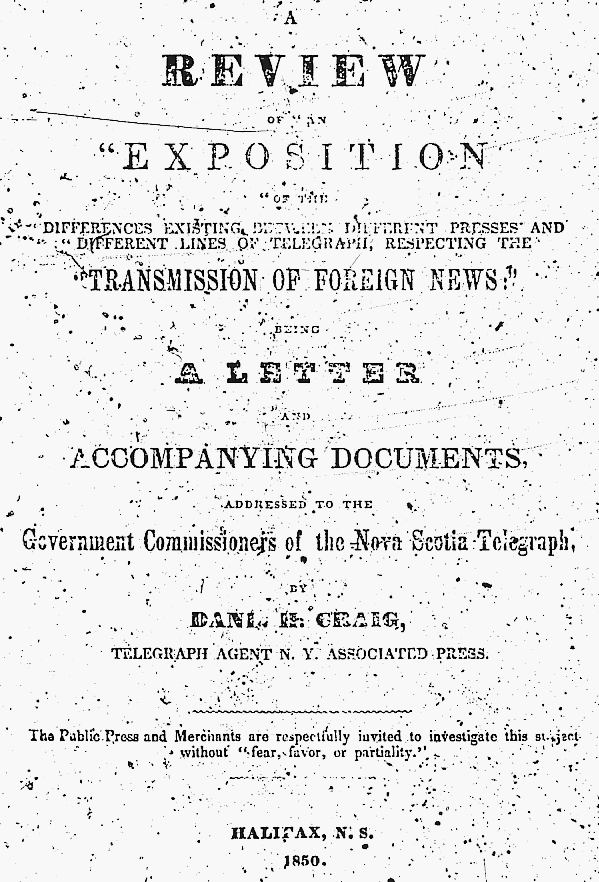
First page of a Letter by Daniel H. Craig, addressed to the
Government Commissioners of the Nova Scotia Telegraph
Joseph Howe, George R. Young, and William Murdoch
Source: Canadian Institute for Historical Microreproductions: CIHM 33361
Excerpt (below) from Daniel Craig's 1850 letter
to the Nova Scotia Telegraph Commissioners
Note: This excerpt is from a public statement (quoted by Craig in his letter)
signed by nine of the most powerful men in New York in 1850:
Gerard Hallock, New York Journal of Commerce
Horace Greeley, New York Tribune
Thomas McElrath, New York Tribune
George H. Andrews, New York Courier & Enquirer
Moses Sperry Beach, New York Sun
Alfred Ely Beach, New York Sun
Erastus Brooks, New York Express
James Brooks, New York Express
James Gordon Bennett, New York Herald
|
Getting The European News to the Public in New York
[Late in 1848, six New York newspapers], the Journal of Commerce, Courier and Enquirer, Herald, Sun, Tribune, and Express, through their Committee, in an interview with Mr. L.R. Darrow, the Superintendent of the Saint John [Electric Telegraph] Line, then nearly finished, arranged to run an
express, on the arrival of each steamer at Halifax, from that point to Saint John, New Brunswick, the eastern terminus of the Telegraph at that time, on condition of having the privilege of transmitting a despatch of three thousand words to Boston and New York, leaving copies if wanted, at the intermediate towns and cities. The press were granted the exclusive use of the wires from the moment their despatch was offered until it was finished. This was deemed necessary to warrant the vast outlay anticipated, and as a protection to the public. Other parties, however, were not shut out from the use of the wires. If they could anticipate our agent at the telegraph office, their messages were sent through to their destination.
The arrangement thus made with Mr. Darrow extended from New York to Saint John, and to Halifax when the line reached that city, and was based, in regard to price, &c, upon a previous contract of a year's standing with Mr. F.O.J. Smith, for the transmission of the steamers' news from Boston to New York. After the papers were signed, Mr. Smith, for certain reasons, refused to be a party to it, and a separate agreement was, therefore, made with him for the use of the lines under his control. In all these arrangements, however, the names and character of the agents to be employed by the press, were not mentioned. There were two competitors for the agency; and the "superior activity" of the man, and the recommendation of two or three editors in Boston, in the Association, induced us to employ Mr. Craig, the present agent.
The Associated Press, previous to the new enterprise, had employed the express steamer Buena Vista to run from Halifax to Boston; and at the time of effecting the arrangement with Mr. Darrow, five of the associated newspapers had the steamer Newsboy employed in cruising off Sandy Hook, for the European steamers. The news brought by the Buena Vista cost nearly $1,000 each time it was transmitted to New York, and the expenses of the Newsboy were at the rate of over $20,000 per annum, which were cheerfully paid by the Courier and Enquirer, Herald, Journal of Commerce, Sun, and Express, the owners of the steamer at that time. After the overland express from Halifax to Saint John was established, the Newsboy was withdrawn, but the cost of getting the European news increased. An examination of the bills of the last year exhibited the enormous expenditure, in that short space of time of $29,700, most of which went into the pockets of the telegraph companies.
These few facts are merely stated en passant. They have, perhaps, very little to do with the principles at issue with Mr. F.O.J. Smith, who seeks to dictate to the merchants and others what agents in New Orleans, Liverpool, or Halifax, they shall employ to do their business. These facts, however, will serve to illustrate the position in which we are placed.
There was no difficulty with Mr. F.O.J. Smith during the time the Buena Vista brought the news to Boston hours and hours in advance of the English steamer. He interposed no objection then to the transmission of her news over his wires to New York. There was no difficulty with Mr. F.O.J. Smith when the Newsboy brought the foreign news ahead of the steamer to this port. He interposed no objection then to the despatch of the news, by telegraph, to Boston. There was no difficulty with Mr. F.O.J. Smith when our overland express reached Saint John one and two days advance of the arrival of the European steamer at this port. He interposed no objection then to the transmission of the news to New York, although, as he well knows, it was the easiest thing in the world to fly a flock of carrier-pigeons across the Bay of Fundy, hours ahead of the express. It was not until the wires were carried to Halifax, that our agent became so very obnoxious to Mr. F.O.J. Smith. It was then that the press were given to understand that another agent must be employed.
We were informed that our agent would use the facilities of the Associated Press to prey upon the mercantile community, and that the wires would be cut in the rear of each American market to which the pigeon would be dispatched. We were advised to employ another agent, who had been kindly selected for us in Boston. This new agent was indeed sent to Halifax, endorsed in the advertising columns of two Boston newspapers, by Mr. F.O.J. Smith, as possessing superior facilities over his lines; and one of the messages of this agent was actually forced upon us, to the exclusion of our own, by F.O.J. Smith; and it was the arrival of this agent at Halifax, with his "superior facilities," that caused the appearance of the carrier pigeons. The Committee of the Associated Press, to all the charges against our own agent, and to the suggestion to employ another, informed Mr. F.O.J. Smith that the Press could not injure a man's character by discharging him on the mere suspicion of another; but that if the charges against the obnoxious agent could be proved, he would not for another moment remain in our employ. The charges continued to be made; but no proof was furnished.
About the middle of last month Mr. F.O.J. Smith wrote to the Associated Press, that as the evening papers of Boston were not connected with us in the reception of the news, he would consider our arrangements at an end. In reply, a circular was addressed by the Committee, on the 29th ultimo to the superintendents of the several telegraph lines between New York and Halifax, that a new contract was necessary, and that any paper securing its share of the cost of getting the steamers' news, could have a copy of the same. This was sent to Mr. F.O.J. Smith, as the Superintendent of the line reaching from New York to Portland. Before, however, it could reach him, he sent the following telegraphic dispatch to the Committee:
Portland, Dec. 21, 1849
To HUDSON & RAYMOND: I have waited without any new information from you on the subject of my last letter. I have now all the evidence I can ask, of Craig's reckless system of business over the telegraph. Until he totally abandons the use of carrier pigeons, I shall refuse transmitting any dispatches from him over either the Portland or the Boston and New York line of telegraph. It is a decision of both self-defence and public policy, from which I shall not recede. If the Associated Press will employ an agent of his utterly disregardless of the interests and responsibilities of our telegraph lines, they must expect counter-measures of defence will be adopted. — They will be by me at least.
F.O.J. Smith
|
After the reception of our circular, he reiterated his demand for the immediate dismissal of our agent. And yet, not a carrier pigeon has been used; the beautiful and innocent doves remaining billing and cooing in their cote, and have not, to our knowledge or belief, flapped a wing for the Associated Press or any other party, since Mr. Craig has been acting as our agent. Such an answer was wholly unexpected. We could not believe that any man having control of such a powerful element of communication from distant points would presume to dictate to the public the agents to be employed in sending messages over the wires. Although denying the right of Mr. F.O.J. Smith in thus dictating to us, we made inquiries into "Craig's reckless system of business;" and all that we could ascertain, was, that a man named Anderson, once in his employ, was detected in Saint John in the act of cutting the wires. How far Mr. Craig was connected with this Anderson, in this affair, is to be seen in the following letter from Mr. L.R. Darrow, the Superintendent of the Saint John [New Brunswick] and Calais [Maine] telegraph line:
Saint John, January 4, 1850
To Messrs. HUDSON & RAYMOND, New York:
A charge has been made against Mr. D. H. Craig, your agent at Halifax, as having been engaged with Mr. Anderson, in cutting the wire. The Directors and myself have carefully examined all the evidence, which went to produce the charges, and the only foundation we can find to hinge even a doubt upon against Mr. Craig, is that he had employed this man Anderson, in connection with Mr. Till, of the New Brunswicker, the one to print, the other to carry his daily dispatches of the New York and Boston markets, to his patrons in Saint John; and this, we think, should not have the least possible effect against him. I would advise the continuance of Mr. Craig as your agent until some proof shall be brought against him, or at least some strong probabilities. I am gentlemen,
With respect and esteem,
yours truly,
L.R. Darrow
|
Such is our statement. But, after all, it has very little to do with the principle in dispute between Mr. F.O.J. Smith (the owner of the line from Portland to Boston, the President of the line from Boston to New York, and the reputed owner of one-forth of Morse's patent) and the Associated Press of Boston and New York. That is a matter of some importance to the community, who are daily sending important and confidential messages over the wires, with the expectation of their safely reaching their destination. It is, therefore, fortunate that the outrageous demand of Mr. F.O.J. Smith is made at this early day, and before the telegraphic system becomes a monopoly. It will be the means of opening the eyes of the commercial community, from one end of the Union to the other. It may prevent such a powerful element of communication from falling into the hands of grasping, corrupt and tyrannical men; and, if so, we shall be happy to have been the cause of thus saving the public.
Meanwhile, however, the merchants, and, indeed, the whole community, should be on their guard. Our efforts to obtain the news will continue. We have expended upwards of $50,000 in the last two years to give the earliest and the latest intelligence from Europe, and we shall not hesitate to expend an equal amount in the nest two years for the same purpose. But between us and the news there are three hundred and fifty miles of telegraph wire, over which the press are not permitted to send a message, unless we consent to employ the agents selected for us by the manager of that line. The commercial community are, therefore, for the present, at the mercy of the speculators.
We now leave this matter. Those who are acquainted with the newspaper press of this city, or country, cannot fail to see that the separate and distinct interests embraced in our Association are quite sufficient for the protection of the public.
Gerard Hallock, Journal of Commerce
Greeley & McElrath, Tribune
Geo H. Andrews, Courier & Enquirer
Beach Brothers, New York Sun
J. & E. Brooks, New York Express
James Gordon Bennett, New York Herald
New York, January 24, 1850
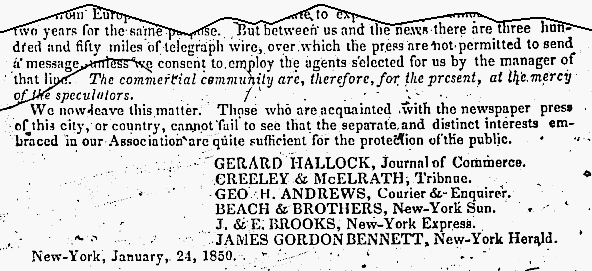
The name "Beach & Brothers" in the above image is an 1850 typesetting error.
This should read "Beach Brothers", referring to the brothers Alfred Ely Beach and
Moses Sperry Beach, who were co-publishers of the New York Sun newspaper.
|
Source: Canadian Institute for Historical Microreproductions
CIHM microfiche #33361
Complete text of Craig's 1850 letter to the Nova Scotia Telegraph Commissioners
http://epe.lac-bac.gc.ca/100/205/300/nova_scotias_electronic_attic/07-04-09/www.littletechshoppe.com/ns1625craig02.html
1850 March 28
Kerosene Gas Light Company
On this day the Act (13 Victoria chapter 25, 1850) to incorporate the Kerosene Gas Light Company was passed by the Nova Scotia Legislature, authorizing 2000 shares to be sold for £20 each, to raise £40,000 to finance the Company, which was formed to "supply the inhabitants of the city of Halifax and town of Dartmouth with gas light" and to install "lamp posts and burners" for street lighting.
Abraham Gesner, Enos Collins, Edward H. Lowe, John Burton, George E. Morton, James C. Cogswell, John P. Mott, Lawrence E. Van Buskirk, and John Silver were named in the Act as the founding shareholders.
On March 31, 1851, an Act (chapter 8, 1851, 14 Victoria) was passed by the Legislature to reduce the authorized capital to £10,000, divided into 1000 shares of £10 each, and placing a three-year deadline for the company to "go into operation", or the enabling legislation would lapse — this appears to be evidence that the company was having difficulty raising capital.
Reference:
Foulis - Gesner Conflict, and the Halifax Gas Light Company...
http://www.saintjohn.nbcc.nb.ca/~Heritage/AlbertMines/FGConflict.htm
1850 April 1
Cunard's Admiralty Contract of 1850
Doubling the Frequency of Mail Service
On this day, a new contract between the British Admiralty, and "Samuel Cunard and George Burns and Charles McIver" (the Cunard Steamship Line) came into effect, which provided for doubling the frequency of the steamship service the company operated, "for the conveyance of Her Majesty's Mails between England and North America". This contract specified that the company would, from then on, "convey the said Mails weekly during eight months in each year and once a fortnight during the remaining four months" of December, January, February, and March in each year. The previous service had been once a fortnight during eight months, and once every four weeks during the four winter months.
1850 July 24
Kings County Wants a Railway
"A meeting of the inhabitants of Kings County was held in the Court House at Kentville on Wednesday, 24th July, 1850 ... for the purpose of ascertaining the views of the inhabitants of said county in reference to a railroad from Halifax to Digby ... It is the opinion of this meeting that the inhabitants of this County will cheerfully furnish the land that is necessary for a Railroad passing through it; also aid with their money, labour and materials to the utmost of their ability, in shares amounting to £25,000..."
The quotations are from a report delivered at the Railroad Convention in Portland, Maine, on 31 July 1850, by the two delegates sent to represent Kings County, John Hall, MPP, and Samuel Chipman. This Convention was attended by representatives of several States, and the Provinces of Quebec, New Brunswick, and Nova Scotia.
The Portland Railway Convention
31 July 1850
The Portland (Maine) Convention of July 31, 1850 was a major influence towards the construction of the European and North American Railway. Simply put, the goal of the 1850 convention was to push for the extension of the New England railroad network through Maine, New Brunswick and Nova Scotia to an ice free harbour as near as possible to Europe.
Source:
Eastern New Brunswick's Railway History, by J.A. Clowes
http://www.trainweb.org/trainorg_temp/canadianrailways/NB/Features/nberh.htm
In the late 1880s, the European and North American Short Line Railway
built a railway in Nova Scotia, from Oxford Junction through Oxford,
Tatamagouche, and Scotsburn, to Brown's Junction (near the Town of Pictou).
This railway was always known as the Short Line, and it continued in
operation into the 1970s — the track between Oxford Junction and
Pugwash carried regular freight trains into the mid-1990s.
|
In 1850, a Railway Convention was held in Portland, Maine. John Poor proposed building a railroad from Halifax, Nova Scotia to Montreal via Saint John and Portland, Maine. There were two companies formed: one under the laws of the State of Maine, and one under New Brunswick laws by the name of "European and North American Railway Company."
- 1853 - The New Brunswick company started construction eastward from Saint John.
- 1856 - The European and North American Railway in New Brunswick was bankrupt.
- 1857 - The New Brunswick Government took over all the European and North American track that had been constructed in New Brunswick...
Source: McAdam Parish History, by Cleadie B. Barnett
http://freepages.history.rootsweb.com/~cannbfam/YO/McAdam/TimeLine.html
1850 October 19
Fifty Passengers a Day
This issue of the Acadian Recorder reported that at least fifty passengers a day were travelling between Halifax and Windsor on the stages. At the time there were two stage companies each operating a daily service between Halifax and Windsor; one of these ran three times a week between Windsor and Annapolis, and the other twice a week between Windsor and Annapolis.
1851 March 31
Passage of Act to Incorporate the
Nova Scotia Electric Telegraph Company
On this day an Act (14 Victoria chapter 17, 1851) to incorporate the
Nova Scotia Electric Telegraph Company was passed by the Nova Scotia Legislature. The Act authorized shares to be sold to raise £20,000 to finance the Company. The founding shareholders included Thomas Killam, William A. Henry, and Hiram Hyde. "The company may build lines of electric telegraph from any point or place to any town, village, hamlet or place in the province, and through, across, or under any stream, gulf, strait, or body of water." If any of the company's lines "shall be down, or out of working order for twenty days in any one time, between any two stations in Nova Scotia or Cape Breton, and for three months across the Gut of Canso, the governor in council may assume control..."
1851 June
Donald McKay's Journey to Liverpool
Mr. Donald McKay, the eminent ship builder, intends to take passage in the clipper ship Sovereign of the Seas, which will sail from New York in a few days for Liverpool, England. We understand that he has two objects in view — first, to ascertain by personal observation afloat, what improvements, if any, can be made in clipper models; and second, to examine the principal shipbuilding establishments of Great Britain. Progressive in his ideas, he is ever on the alert to increase his professional knowledge...
Boston Daily Atlas, 18 June 1851 — Transcribed by Lars Bruzelius
http://pc-78-120.udac.se:8001/WWW/Nautica/News/BDA/BDA(1851-06-18).html
1851 July
The New Steamer S.S. Lewis,
the Pioneer of the Ocean Steamship Co's Line
of Boston and Liverpool Packets
This item has no direct connection with Nova Scotia, but it is the
most detailed description I've seen anywhere of a new steamship of this era.
A few weeks since we stated that the Ocean Steamship Company of New England, contemplated establishing a line of steam packets, to run regularly between this port and Liverpool, that the pioneer ship of the line was progressing rapidly in her outfits, and that three others, of larger dimensions and greater power, would soon be built to complete the line. We have since inspected the pioneer ship...
In every plank, through every frame up to the waist, there are two locust treenails, wedged in one end and plugged in the other, and also two composition spikes, ½ inch 13 mm on the squares and 8 inches 20 cm long. Below the main deck she has 12,000 bolts, driven from the outside through all, and riveted on the inside...
Her motive power consists of two engines, with 60 inch 152 cm cylinders, and 40 inches 101 cm stroke ... The propeller shaft is 11 inches 28 cm in diameter, 67 feet 20.4 m long ... The propeller is of iron, 14 feet 4.3 m in diameter, with 4 fans (blades), formed at angles of 50 degrees, and their greatest width or face is 3 feet 6 inches 107 cm ... Her engines will work 30 pounds pressure to the square inch 200 kPa, and produce 12 knots 22 km/h speed in moderate weather ...
Boston Daily Atlas, 31 July 1851 — Transcribed by Lars Bruzelius
http://pc-78-120.udac.se:8001/WWW/Nautica/News/BDA/BDA(1851-07-31).html
It is most unusual to find this wealth of detail (the above is only a tiny sample) in descriptions of ships of those days. We are given details about the steam engine, such as cylinder and crankshaft dimensions, and steam pressure, that are extremely rare. Mr. Bruzelius has made a significant contribution to the Internet's historical resources.
1852 January 1
Cunard's Admiralty Contract of 1852
for Weekly Mail Service During Winter Months
On this day, a new contract became effective, between the British Admiralty and "Samuel Cunard of Halifax in Nova Scotia, Merchant, George Burns of Glasgow in that part of Great Britain called Scotland, Merchant, and Charles McIver of Liverpool in the County Palatine of Lancaster, Merchant, hereinafter designated The Contractors" to increase the transatlantic steamship mail service, during the four winter months, from once a fortnight to once a week. This new contract was in addition to the service provided under the existing contract of 1 April 1850; it simply filled in the voyages in alternate weeks during December through March which the 1850 contract had omitted. The new contract, like the existing contract, stipulated that The Contractors "shall with all possible speed convey Her Majesty's Mails (in which designation all Despatches and Bags of Letters are agreed to be comprehended) ... between England and North America ... by means of a sufficient number of good substantial and efficient Steam Vessels, each of such Vessels being equipped with Engines of not less than Four Hundred Horse Power" 300 kilowatts. This contract specified an additional annual payment of £28,340 by the British Government to the Cunard Line, the subsidy to be paid quarterly with the first quarterly payment to become due on 1 April 1852. The Cunard Line was now under contract to provide a voyage departing Liverpool every Saturday throughout the twelve months of each year; with the destinations alternating between Boston and New York. The return voyages to Liverpool were specified to depart on every Wednesday, alternately from Boston and New York. The trips between Liverpool and Boston, in both directions, were to stop at Halifax to deliver and pick up passengers and mail. (The New York trips bypassed Halifax.) The contract specified a strict schedule; each ship was to depart at the scheduled hour on the scheduled day. There was a penalty of £100 for each failure to depart "at exact time". If a scheduled departure was delayed for "Twelve Hours after the proper and appointed time" the Contractors had to pay a penalty of £500, "and also the further sum of £500 for every successive period of Twelve Hours which shall elapse until such vessel shall proceed on her voyage".
1852 March 30
Railway from Halifax to Quebec
On this day, the British Imperial government authorized a railroad from Halifax to Quebec.
[The National Post, 30 March 1999]
1852 March 31
Windsor Kerosene Gas Light Company
On this day, 15 Victoria chapter 44, An Act to incorporate the Windsor Kerosene Gas Light Company was passed by the Nova Scotia Legislature. The Act authorized 500 shares to be sold for £10 each, to raise £5,000 to finance the Company. Theodore S. Harding and Benjamin DeWolfe were named in the Act as two of the founding shareholders of the Company.
On 7 May 1874, under 37 Victoria chapter 84, the Company's name was changed to the Windsor Gas Light Company.
1852 May 17
Cunard's Captains Paid $2,500 a Year
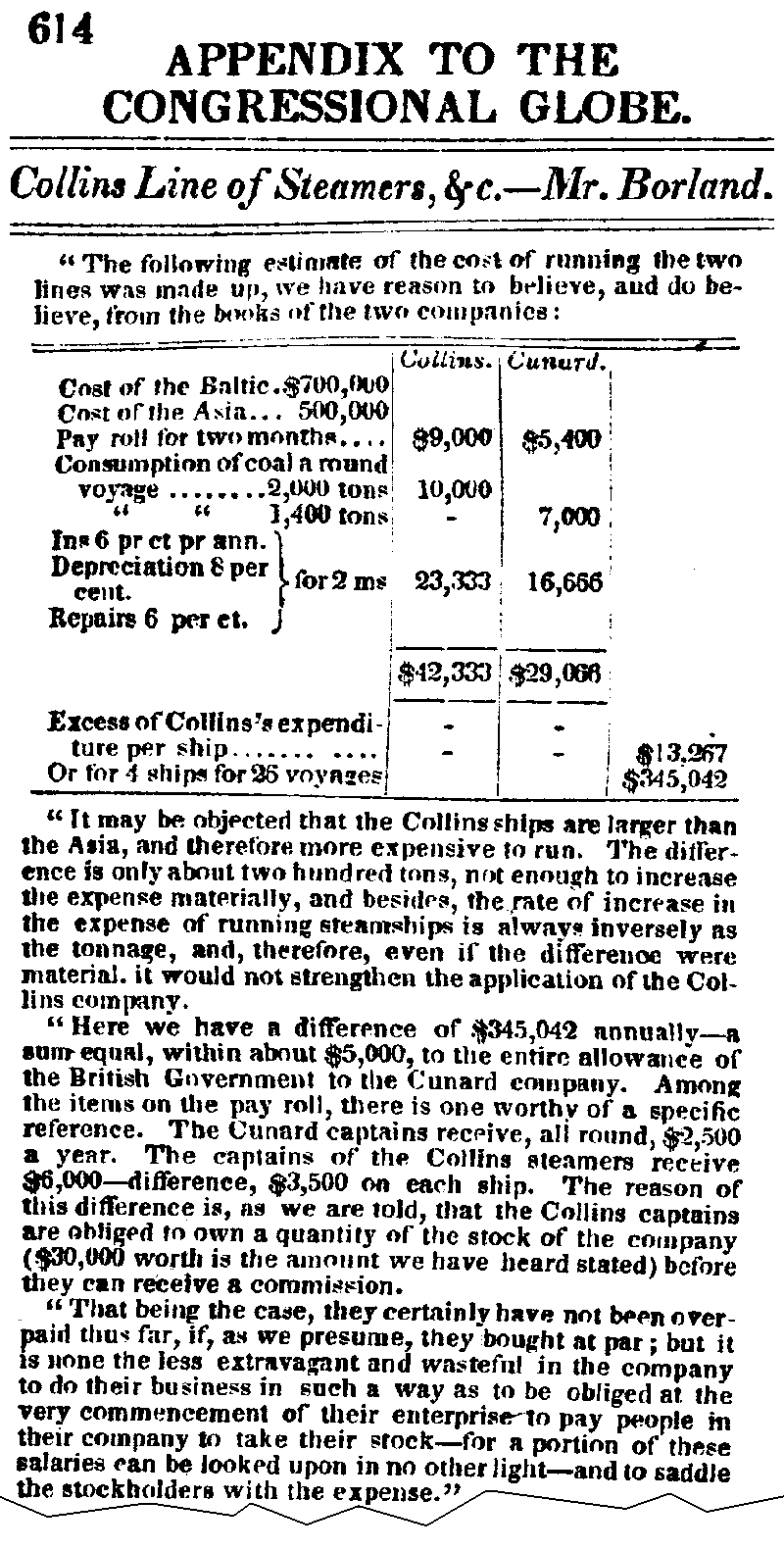
Excerpt related to the Cunard Steamship Line
from S. Borland's speech, May 17, 1852
Appendix to the Congressional Globe, page 614
United States Congress
Source: Historical Collections for the U.S. National Digital Library
http://memory.loc.gov/ll/llcg/030/0600/06260614.tif
Solon Borland (1808-1864): a Senator from Arkansas; born in Virginia, September 21, 1808; attended preparatory schools in North Carolina; studied medicine and afterwards practiced; settled in Little Rock, Arkansas; served throughout the Mexican War as a major in the Arkansas Volunteer Cavalry; was appointed and subsequently elected as a Democrat to the United States Senate to fill a vacancy and served from March 30, 1848, to April 3, 1853, when he resigned; chairman, Committee on Printing (31st and 32nd Congresses), Committee on Public Lands (33rd Congress); served as United States Minister to Nicaragua and to the other Central American Republics 1853-1854; declined an appointment as Governor of the Territory of New Mexico; returned to Arkansas and resumed the practice of medicine in Little Rock until 1861; during the Civil War raised a brigade of troops for the Confederate Army; later was appointed a brigadier general in the Confederate Army; died near Houston, Texas, on January 1, 1864.
Source:
Biographical Directory of the United States Congress
http://bioguide.congress.gov/scripts/biodisplay.pl?index=B000642
Cost of the Asia . . . $500,000
(Congressman Borland's speech, page 614)
The British and North American Royal Mail Steam Packet Company — the Cunard Line — launched two new ships early in 1850, Asia and Africa. They were nearly identical in design and construction. Asia was launched first, in January 1850, and departed Liverpool on Saturday, 18 May 1850, on her first trip across the North Atlantic.
The British and North American Royal Mail steamship Asia, H. E. Judkins commander, arrived at Boston on Tuesday [28 May 1850]. Asia made her passage across the Atlantic in the short time of 9¼ days.
Source:
Roman Citizen newspaper, Rome, New York, 5 June 1850
http://istg.rootsweb.com/newsarticles/1850_newsarticles.html
|
1852 June 7
Disaster on Minas Basin
Seven people drowned in the sinking of a boat on Minas Basin on June 7th, 1852. "In his sermon during the memorial service in the Baptist Meeting House in Wolfville, Acadia College President Cramp spoke of the loss of 'the six precious souls and a man from Gaspereau.' " The six were a professor and four students from Acadia College, and a Baptist minister from Saint John, New Brunswick. The 'man from Gaspereau' was unidentified for many years — he was Perez Coldwell, 29 February 1808 - 7 June 1852.
[The Kentville Advertiser, 11 July 2000]
Plaque For Gaspereau Man
Readers of this newspaper may have seen the March 3rd, 2000, story about the 1852 sinking of a sailboat in the Minas Basin. The "man from Gaspereau," a phrase immortalized locally, referred to the loss Perez Coldwell who along with another Gaspereau resident, George Benjamin, manned the ill-fated sailboat.
Readers interested in this tragic tale are referred to Esther Clark Wright's book, Blomidon Rose, chapter 12. Wright describes the incident in detail. The loss of Isaac Chipman and the students was a serious blow to a young Acadia University. "The loss of the students meant that there were none to graduate the following year and only one the year after," Wright wrote.
I have none of the details but I understand that a move is afoot to preserve the memory of Perez Coldwell and the 1852 tragedy. Roscoe Potter, Wolfville, is spearheading a fund raising effort that hopefully will result in a cairn-mounted plaque. No decision has been made on where the cairn will be placed but Potter says the most likely site is the Gaspereau Valley.
[Ed Coleman's column in the Kentville Advertiser, 31 March 2000]
http://www3.ns.sympatico.ca/ecoleman/editorial/2000/e00mar31.html
Perez Coldwell memorial, 1852 "A man from Gaspereau"
http://ns1763.ca/kingsco/coldwellp.html
First Telegram at Yarmouth
The first incoming telegram was received at the new Yarmouth telegraph office. Sent from Wolfville and addressed to The Yarmouth Herald, it described the accidental drowning of six people in the Bay of Fundy, including Professor Chipman of Acadia University.
[I believe this item came from the book Yarmouth Reminiscences, by J. Murray Lawson, 1902. Note that it speaks of "six" people — apparently the 'man from Gaspereau' wasn't counted in the contemporary accounts. Murray Lawson's book consisted mainly (perhaps exclusively) of clippings from back issues of The Yarmouth Herald.]
1852 June 24
Antigonish Casket Begins Publication
On this day, the Casket Printing and Newspaper began publication under publisher John Boyd. Its motto: "Liberty - choicest gem of the Old World and fairest flower of the new".
Source:
Antigonish Regional Development Authority website
http://www.antigonishrda.ns.ca/funfacts.html
In 2002, the Casket newspaper continues regular weekly publication.
1852 July 3
Cunard Paid $16,000 per Trip
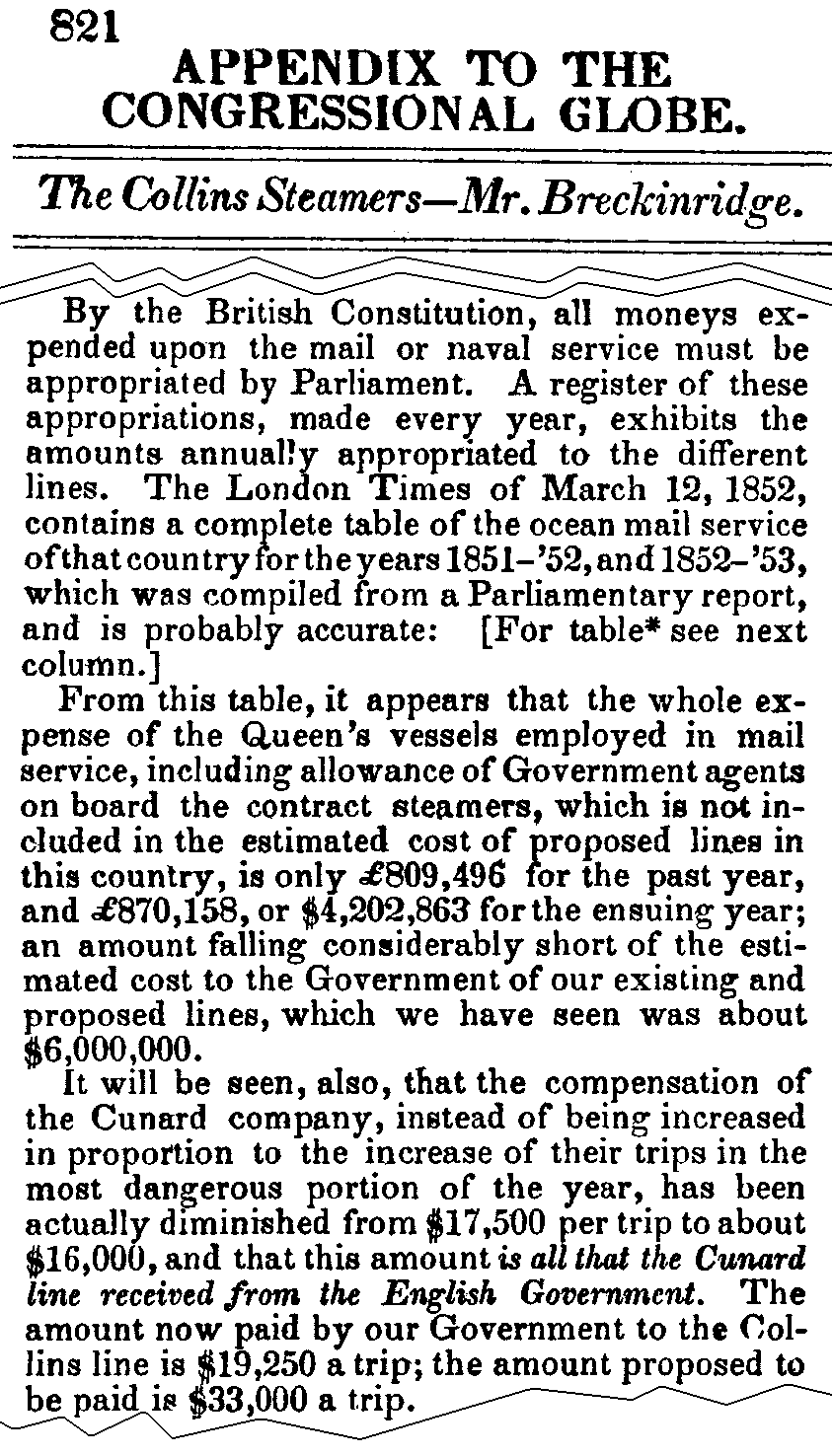
Excerpts related to the Cunard Steamship Line
from J.C. Breckinridge's speech, July 3, 1852
Appendix to the Congressional Globe, page 821 column 2
United States Congress
Source: Historical Collections for the U.S. National Digital Library
http://memory.loc.gov/ll/llcg/030/0800/08330821.tif
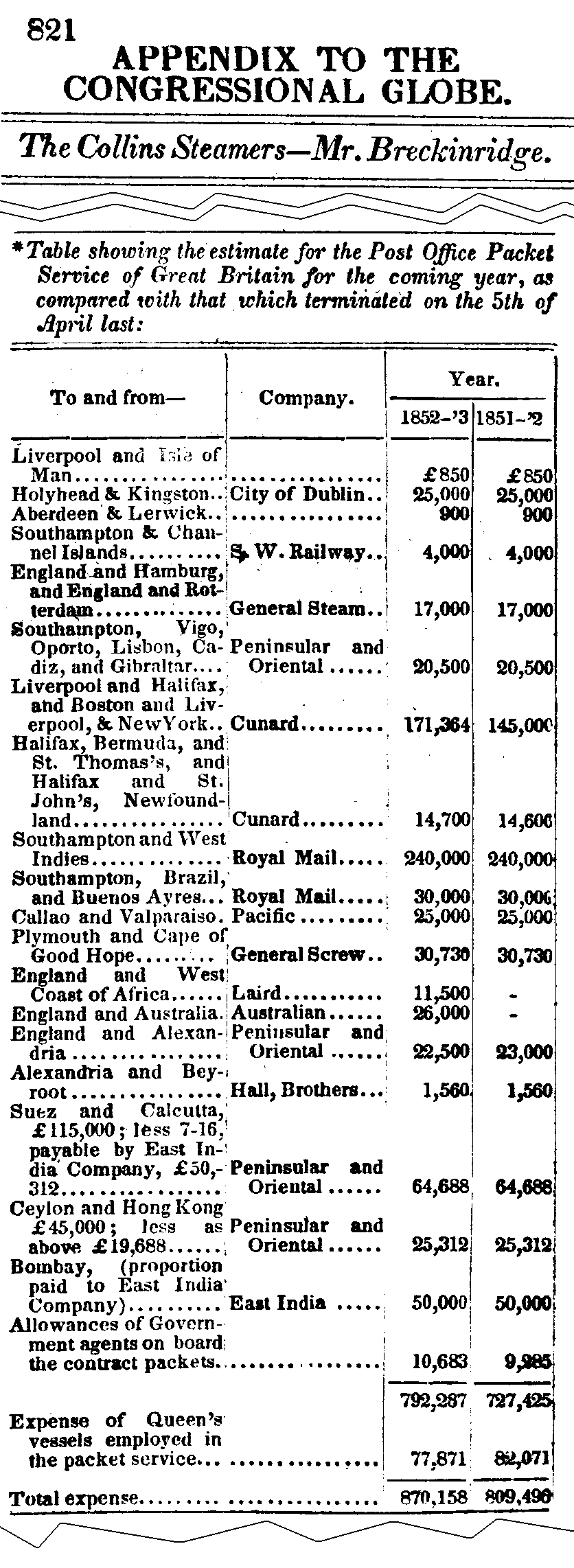
Excerpts related to the Cunard Steamship Line
from J.C. Breckinridge's speech, July 3, 1852
Appendix to the Congressional Globe, page 821 column 3
United States Congress
Source: Historical Collections for the U.S. National Digital Library
http://memory.loc.gov/ll/llcg/030/0800/08330821.tif
John Cabell Breckinridge (1821-1875): a Representative and a Senator from Kentucky and a Vice President of the United States; born in Kentucky, January 16, 1821; attended the College of New Jersey (now Princeton University); studied law in the Transylvania Institute, Lexington, Kentucky; was admitted to the bar in 1840; major of the Third Kentucky Volunteers during the Mexican War in 1847 and 1848; member, State house of representatives 1849; elected as a Democrat to the 32nd and 33rd Congresses (March 4, 1851-March 3, 1855); was not a candidate for renomination in 1854; elected Vice President of the United States in 1856 on the Democratic ticket with James Buchanan as President; unsuccessful candidate for President in 1860; elected to the United States Senate and served from March 4, 1861, until expelled by resolution of December 4, 1861, for support of the rebellion; entered the Confederate Army during the Civil War as brigadier general and soon became a major general; Secretary of War in the Cabinet of the Confederate States from January until April 1865; resided in Europe until 1868; returned to Lexington, Kentucky, and resumed the practice of law; vice president of the Elizabethtown, Lexington Big Sandy Railroad Co.; died in Lexington, Ky., May 17, 1875.
Source:
Biographical Directory of the United States Congress
http://bioguide.congress.gov/scripts/biodisplay.pl?index=B000789
NOTES: The following is an attempt to identify the companies listed in the "Company" column in the table above for 1851-1852: Table showing the estimate for the Post Office Packet Service of Great Britain...
The entries are listed below in the order in which they appear in the table:
S. W. Railway
London and South Western Railway Company for many years operated a mail and passenger service between Southampton and the Channel Islands.
General Steam
General Steam Navigation Company (taken over by Peninsular & Oriental in 1920)
Peninsular and Oriental
Peninsular and Oriental Steam Navigation Company
Cunard
British and North America Royal Mail Steam Packet Company (The Cunard Line) ran a weekly mail and passenger service between Liverpool, England, and Halifax, Boston and New York.
Royal Mail
Royal Mail Steam Packet Company began shipping operations in 1841.
Pacific
Pacific Steam Navigation Company was formed in London in 1838. The company commenced operations on the West Coast of South America in 1840, and obtained the British Government Mail contract to the area in 1852. From the 1840s until the 1920s operated a service between England and Valparaiso - Callao - Guayaquil - Panama.
General Screw
General Screw Steam Shipping Company ran a monthly mail service from Plymouth, England, to Calcutta, India via St. Vincent, Ascension, St. Helena, Cape Town, Mauritius, Ceylon, and Madras.
Laird
MacGregor Laird
Australian
European and Australian Royal Mail Company
Hall, Brothers
Hall Brothers Steam Ship Company Ltd.
East India
English East India Company
|
1852 July 6
In the first six years of Cunard operations
the Government of Great Britain received for postage $7,836,800

Excerpts related to the Cunard Steamship Line
from J.R. Chandler's speech, July 6, 1852
Appendix to the Congressional Globe, page 782 column 2
United States Congress
Source: Historical Collections for the U.S. National Digital Library
http://memory.loc.gov/ll/llcg/030/0700/07940782.tif

Excerpts related to the Cunard Steamship Line
from J.R. Chandler's speech, July 6, 1852
Appendix to the Congressional Globe, page 782 column 3
United States Congress
Source: Historical Collections for the U.S. National Digital Library
http://memory.loc.gov/ll/llcg/030/0700/07940782.tif
Joseph Ripley Chandler (1792-1880): a Representative from Pennsylvania; born in Kingston, Massachusetts, August 22, 1792; moved to Philadelphia, Pennsylvania, in 1815; editor of the United States Gazette 1822-1847; member of the Philadelphia city council 1832-1848; elected as a Whig to the 31st, 32nd, and 33rd Congresses (March 1849 - March 1855); unsuccessful candidate for reelection in 1854 to the 34th Congress; appointed by President Buchanan as Minister to the Two Sicilies and served from June 15, 1858, to November 15, 1860; president of the board of directors of Girard College; died in Philadelphia July 10, 1880.
Source:
Biographical Directory of the United States Congress
http://bioguide.congress.gov/scripts/biodisplay.pl?index=C000292
1852 July 6
Collins Line v. Cunard
The New York and Liverpool United States Mail Steamship Company
v.
The British and North American Royal Mail Steam Packet Company

Excerpts related to the Collins Steamship Line
(Collins v. Cunard) from B. Stanton's speech, July 6, 1852
Appendix to the Congressional Globe, page 785 column 2
United States Congress
Source: Historical Collections for the U.S. National Digital Library
http://memory.loc.gov/ll/llcg/030/0700/07970785.tif
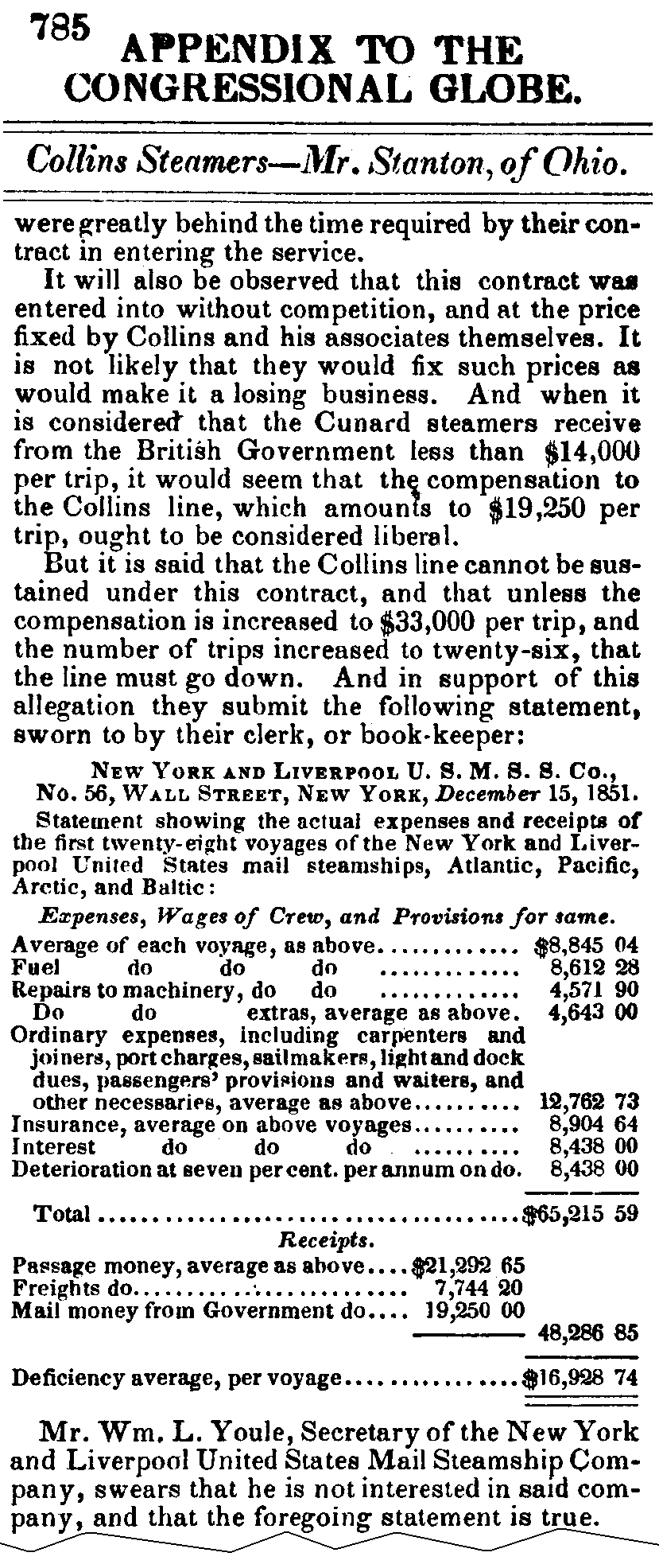
Excerpts related to the Collins Steamship Line
(Collins v. Cunard) from B. Stanton's speech, July 6, 1852
Appendix to the Congressional Globe, page 785 column 3
United States Congress
Source: Historical Collections for the U.S. National Digital Library
http://memory.loc.gov/ll/llcg/030/0700/07970785.tif
Benjamin Stanton (1809-1872): a Representative from Ohio; born in Ohio, June 4, 1809; member of the Ohio State senate in 1841 and 1843; delegate to the State constitutional convention in 1850; elected as a Whig to the 32nd Congress (March 1851 - March 1853); elected as a Republican to the 34th, 35th, and 36th Congresses (March 1855 - March 1861); chairman, Committee on Military Affairs (36th Congress); Lieutenant Governor of Ohio in 1862; moved to Martinsburg, West Virginia, in 1865, and practiced law; moved to Wheeling, West Virginia, in 1867 and continued the practice of law; died in Wheeling, West Virginia, June 2, 1872.
Source:
Biographical Directory of the United States Congress
http://bioguide.congress.gov/
1852 July 7
Shipping Statistics for North Atlantic, 1851 and 1852
Cunard and other lines

Excerpts related to the Cunard Steamship Line
from G.S. Houston's speech, July 7, 1852
Appendix to the Congressional Globe, pages 802-805
United States Congress
Source: Historical Collections for the U.S. National Digital Library
page 802: http://memory.loc.gov/ll/llcg/030/0800/08140802.tif
page 803: http://memory.loc.gov/ll/llcg/030/0800/08150803.tif
page 804: http://memory.loc.gov/ll/llcg/030/0800/08160804.tif
page 805: http://memory.loc.gov/ll/llcg/030/0800/08170805.tif
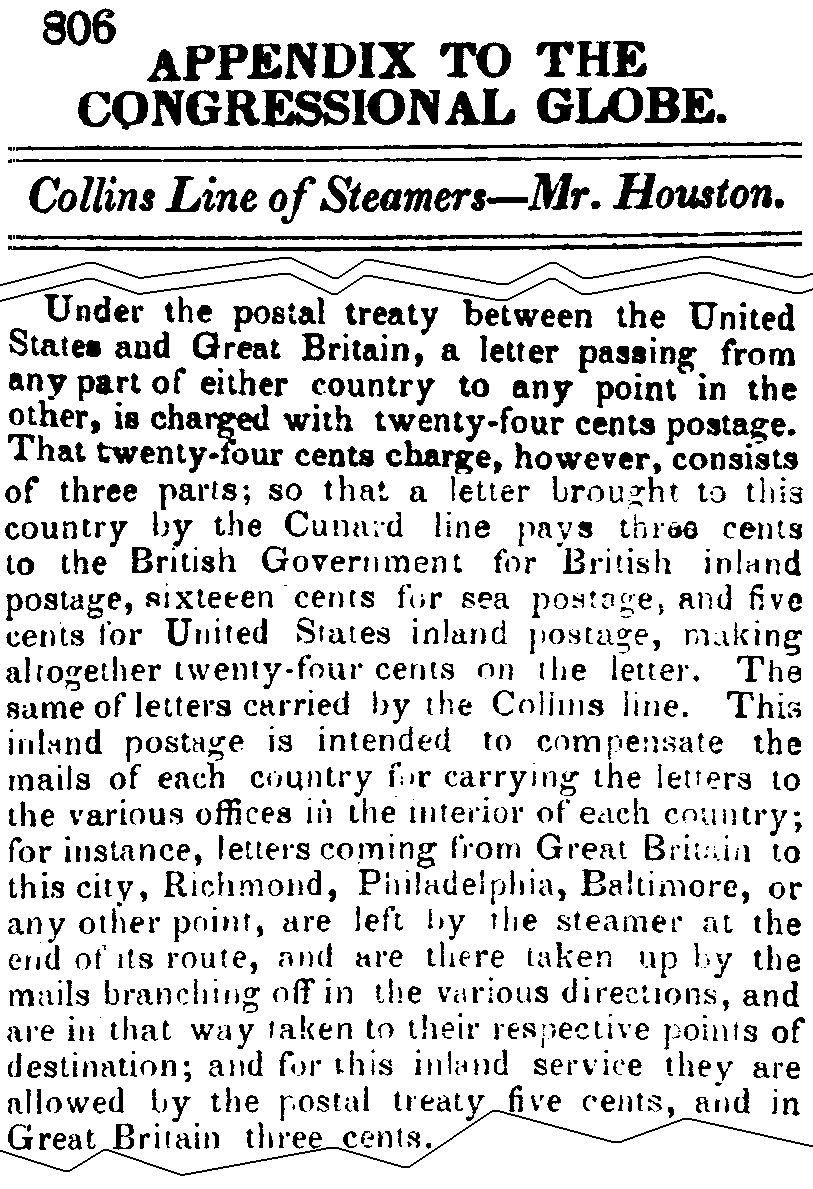
Excerpts related to the Cunard Steamship Line
from G.S. Houston's speech, July 7, 1852
Appendix to the Congressional Globe, page 806
United States Congress
Source: Historical Collections for the U.S. National Digital Library
http://memory.loc.gov/ll/llcg/030/0800/08180806.tif
George Smith Houston (1811-1879); born in Tennessee, January 17, 1811; member, State house of representatives 1832; elected as a Democrat to the 27th and to the three succeeding Congresses (March 1841 - March 1849); declined to be a candidate for renomination in 1848; elected to the 32nd and to the four succeeding Congresses and served from March 1851 until January 1861, when he withdrew; chairman, Committee on Ways and Means (32nd and 33rd Congresses), Committee on Judiciary (35th Congress); Governor of Alabama 1874-1878; elected to the United States Senate and served from March 1879, until his death in Alabama, December 31, 1879.
Source:
Biographical Directory of the United States Congress
http://bioguide.congress.gov/scripts/biodisplay.pl?index=H000822
1852 July 9
Cunard Worries the U.S. Congress
These two steamship lines, the Collins and the Cunard,
are the representatives on the ocean
of the two great commercial powers of the globe
"No one will doubt the necessity of the United States having a steam navy,
when that of England consists of nearly 300 war steamers"
(Cunard's fleet was included in the "nearly 300 war steamers")

Excerpts related to the Cunard Steamship Line
from Gilbert Dean's speech, July 9, 1852
Appendix to the Congressional Globe, pages 813-814
United States Congress
Source: Historical Collections for the U.S. National Digital Library
page 813: http://memory.loc.gov/ll/llcg/030/0800/08250813.tif
page 814: http://memory.loc.gov/ll/llcg/030/0800/08260814.tif
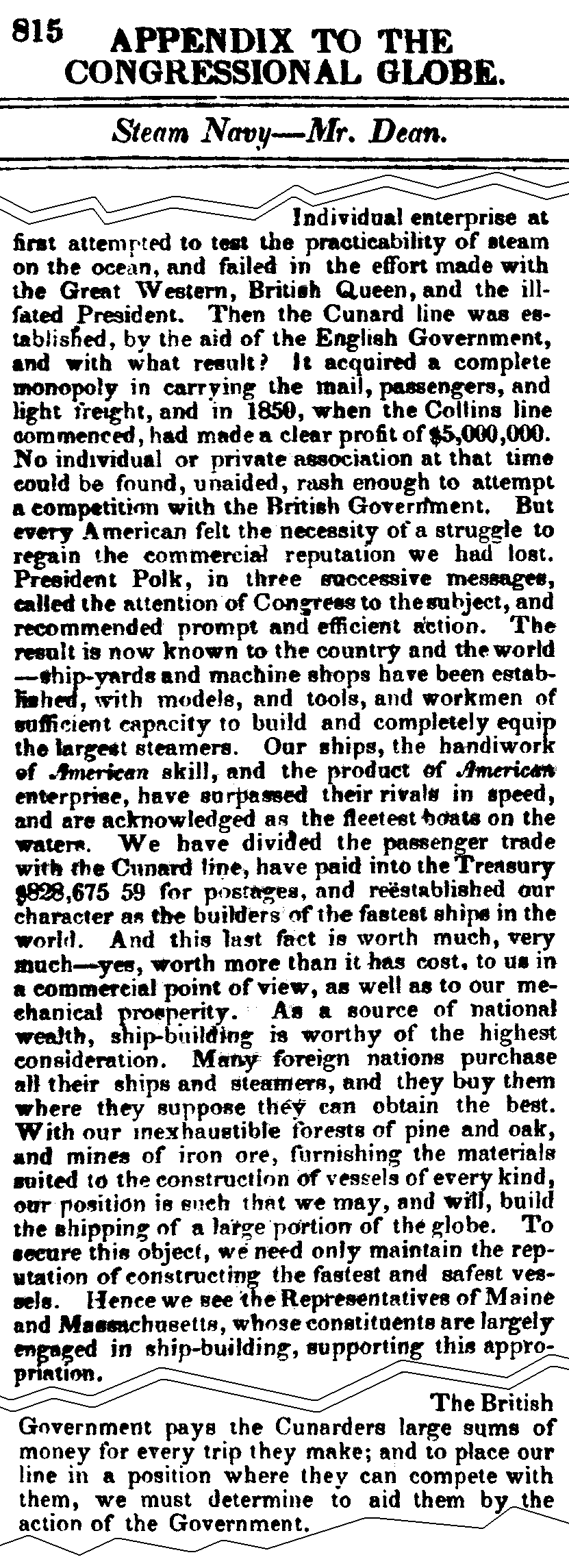
Excerpts related to the Cunard Steamship Line
from Gilbert Dean's speech, July 9, 1852
Appendix to the Congressional Globe, page 815
United States Congress
Source: Historical Collections for the U.S. National Digital Library
http://memory.loc.gov/ll/llcg/030/0800/08270815.tif
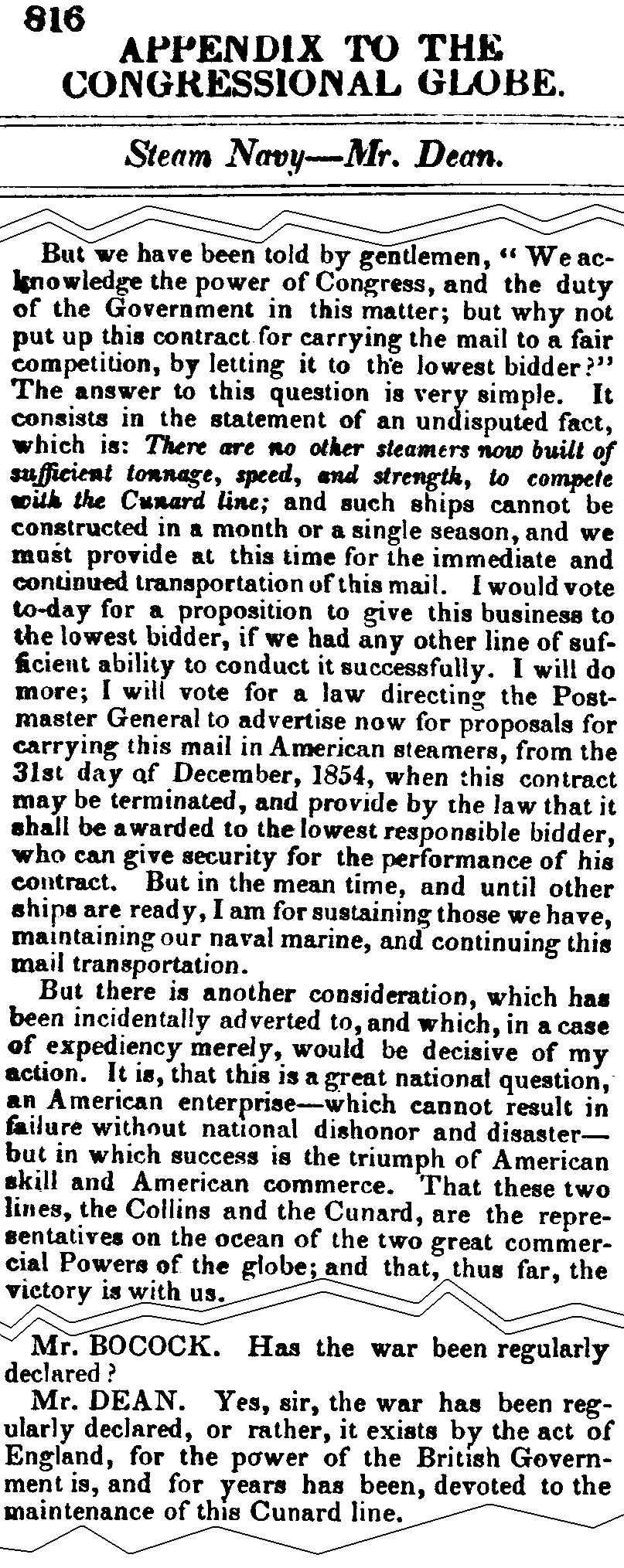
Excerpts related to the Cunard Steamship Line
from Gilbert Dean's speech, July 9, 1852
Appendix to the Congressional Globe, page 816
United States Congress
Source: Historical Collections for the U.S. National Digital Library
http://memory.loc.gov/ll/llcg/030/0800/08280816.tif
Gilbert Dean (1819-1870): Born in New York state, August 14, 1819. Graduated from Yale College in 1841; elected as a Democrat to the 32nd and 33rd Congresses and served from March 1851, to July 1854, when he resigned to become a New York state court judge. Died October 12, 1870.
Source:
Biographical Directory of the United States Congress
http://bioguide.congress.gov/scripts/biodisplay.pl?index=D000172
New York and Liverpool United States Mail Steamship Company
The Collins Line
E.K. Collins & Company
What is the Collins Line?
Where does Cunard come in here?
Congressman Dean was speaking
on the topic Steam Navy
Messrs. James Brown, E.K. Collins, E. Riggs and W.S. Wetmore, of New York, have announced their intention of applying to the Legislature of the State, to incorporate themselves and others under the name of the New York and Liverpool United States Mail Steamship Company, with a capital of $2,000,000, for the purpose of running a line of steamers between New York and Liverpool.
[New Brunswick Courier, Saint John, 20 January 1849]
From 1850 to 1858, Cunard's main competitor on the North Atlantic was the New York and Liverpool United States Mail Steamship Company, run by Edward Knight Collins and usually known as the Collins Line.
In 1847, Collins negotiated an annual subsidy for his company of $385,000 from the United States government, and ordered four new 2,885-ton, wooden-hulled side-wheel steamships, the world's largest at the time. The first vessel of this fleet was named Atlantic, and the others were Pacific, Baltic, and Arctic. These ships were much larger and more comfortable, more powerful and faster than anything Cunard had.
Atlantic and Pacific were launched on the same day, February 1, 1849. The paddle wheels were 36 feet in diameter, with 36 paddles. Each ship was powered by two side-lever 800-horsepower [600 kW] engines. Each engine had one cylinder 95 inches (nearly eight feet) [241 cm] in diameter, supplied with steam at seventeen pounds per square inch pressure [120 kPa] (which was about the highest pressure that could be delivered safely and reliably by the boiler technology of the time). With both engines running at full power, about sixteen revolutions per minute, and a little assistance from auxiliary sails, Collins' steamers could make 12 or 13 knots (23 to 25 km/h) most of the time. Their coal consumption was enormous, one ton for every 265 revolutions of the paddle wheels, or 85 tons in 24 hours; in a round trip one of these ships burned a quantity of coal almost equal to the ship's tonnage. Put in modern terms, they got about 6 kilometres (4 miles) to the ton.
Cunard's primary operating policy was reliability, not speed. Collins emphasized speed, which was good publicity but very expensive. From the beginning, the Collins Line was faster than Cunard on the Atlantic crossing. Atlantic sailed for Liverpool on her maiden voyage on April 27, 1850. She returned to New York in ten days sixteen hours, setting a new record time westbound.
By then, captains, owners, and the newspapers could see it coming — a transatlantic trip in under ten days. In 1851, Cunard averaged 11 days 12 hours eastbound, and 12 days 9 hours westbound; Collins averaged 10 days 21 hours eastbound and 11 days 3 hours westbound.
In April 1852, from Liverpool, Pacific reached Sandy Hook in nine days twenty hours fifteen minutes, the first ship, sail or steam, to cross the Atlantic to New York in under ten days.
The four new Collins ships were lavishly designed. Passengers were served good food well prepared, and lots of it. For food storage, there was a refrigerator — a room which was stocked with forty tons of ice before each departure. There was provision for passengers to bathe — before these vessels there was no such arrangement, even for voyages that often took a month and sometimes two.
The Collins ships were expensive to operate, and the Collins company had a hard time financially. It was completely dependent on substantial subsidies from the United States government, and year by year there was increasing political opposition to continuing these subsidies. The long debate in the U.S. House of Representatives Committee on the Post Office and Post Roads in July 1852, and again in February 1855, was part of this continuing struggle between those who wanted to use U.S. government money to keep the Collins Line operating on the North Atlantic, and those opposed.
Collins' financial problems were intensified by the loss of two ships, half of his fleet. About noon on September 27, 1854, Arctic, eight days out of Liverpool and 60 miles 100 km south of Cape Race, Newfoundland, collided with the French bark Vesta while steaming at 11 knots in a dense fog; Arctic sank about 5pm with the loss of 323 lives (the casualties included 92 of Arctic's 153 officers and men, and all her women and children were lost including the wife, the only daughter, and the youngest son of E.K. Collins). Collins now had three ships, barely enough to perform the mail contract. On January 25, 1856, Pacific cleared Liverpool with 145 passengers and 140 crew. She thrashed her way out into St. George's Channel, passed Tuskar Light, and was never seen again. To this day, no one knows what happened to Pacific; no wreckage or debris from the steamer was ever found. Collins now had two ships. Even before the loss of Pacific, his credit was stretched to the limit by the cost of the new 4000-ton screw steamer Adriatic, being built to replace Arctic. Adriatic was launched in September 1856.
The last trip by a Collins ship ended when Baltic tied up at New York on February 18, 1858. The entire Collins fleet — all three remaining ships, Atlantic, Baltic, and Adriatic — was sold at auction on April 1, 1858, for just $50,000. (Collins had paid more than $1,800,000 to have these three ships built.)
Sources:
The Magnificent Failure, by E. Milburn Carver, (a history of the Collins Steamship Company), originally published in Yankee Magazine (date not known), anthologized in Yankees Under Steam, edited by Austin N. Stevens, published by Yankee, Inc., Dublin, New Hampshire, 1970.
Steam at Sea: Two Centuries of Steam-Powered Ships by Denis Griffiths, Conway Maritime Press, 1997, ISBN 0851776663.
References:
http://www.blueriband.com/Portraits/BAAPA/body_baapa.html
http://www.greatoceanliners.net/arctic.html
http://ns1763.ca/ponyexpress/ponyex13.html
Other shipping lines sacrificed safety for speed, and lives were lost, but not a single life was lost on a Cunard ship in the first 75 years of the company's history — an incredible and unparalleled record. The first disaster his company experienced — the sinking of Lusitania torpedoed by a German submarine on May 7, 1915 — occurred 50 years after Cunard's death in 1865. (Several modern sources make the monumental mistake of linking Titanic to Cunard, but Titanic was not a Cunard ship. Titanic was built, owned, and operated by the White Star Line, a company independent of and in competition with Cunard. Two decades after Titanic's brief career ended dramatically in April 1914, during the financial difficulties associated with the Great Depression of the 1930s, the British Government forced the merger of Cunard with White Star, and this later association no doubt is the source of the confusion about Titanic's ownership.)
|

Collins ships, Atlantic, Pacific, Arctic, Baltic
Appendix to the Congressional Globe, July 6, 1852, page 786
United States Congress
Source: Historical Collections for the U.S. National Digital Library
http://memory.loc.gov/ll/llcg/030/0700/07980786.tif
1852 August 11
Telegraph Line Completed, Halifax to Sydney
The first telegraph line was completed between Halifax and Sydney, built by the Nova Scotia Electric Telegraph Company. It was carried across the Strait of Canso by a wire stretched from Cape Porcupine to a mast at MacKean's Point.
1852 December 8
Cunard's First Iron-Hulled, Screw-Driven Vessel
Cunard's first iron-hulled, screw-driven vessel, Andes, began her maiden voyage from Liverpool, England, to New York, on 8 Decemebr 1852, but had to put back to Liverpool because of a technical glitch. The problem was solved in a couple of weeks and Andes then completed a successful trip to New York. It was used as a Crimean War transport in 1854.
Source: http:www.cunardline.com/index.cfm
1854
Eastern Stage Coach Company
(HYDE'S LINE)
Halifax to Truro and Pictou
Leaves Halifax for Truro and Pictou every morning (except Sunday) by the first boat crossing to Dartmouth. On Monday, Wednesday, and Friday mornings for St. John, N.B. and on Wednesday and Friday mornings to meet the Steamer at Pictou for Prince Edward Island.
Returning, leaves Pictou for Truro and Halifax every morning (except Sunday). The Steamer from P.E. Island arrives at Pictou on Tuesdays and Thursdays.
Office — Argyle Street, upper side Grand Parade, Halifax.
[This is the complete text of an advertisement in Belcher's Almanack, 1854.]
|
"Hyde's Line" means this stage line was owned and operated by the renowned Hiram Hyde, who played an important part in the development of transportation and communications in Nova Scotia for sixty years, from 1840 until 1900.
|
1854 April 15
New York, Newfoundland & London Telegraph Company
On this day, the Newfoundland Legislature passed an Act to incorporate the New York, Newfoundland & London Telegraph Company, and the Company was formally organized on 6 May 1854. This company's line would have to go across Nova Scotia. The Act names founding shareholders: Peter Cooper, Moses Taylor, Cyrus W. Field (retired New York paper merchant), Marshall O. Roberts (of the Erie Railroad), Chandler White, and Frederick N. Gisborne.
1854 June 13
Nova Scotia Railway
On this day, construction started on the Nova Scotia Railway at Richmond, near Halifax.
[The National Post, 13 June 2000]
Note (24 May 2002): The railway track, built in the 1850s by the Nova Scotia Railway from Richmond to Truro, eventually became part of the ICR (Intercolonial Railway) main line track between Montreal and Halifax — and in 2002 most of it, the section between Rockingham and Truro, remains in daily operation as the CN main line. Beginning in 1878 and continuing until 1917, the ICR main line track into Halifax terminated at the North Street Station located at the northeast corner of the intersection of Barrington Street with North Street, on the land now occupied by the West Cable Anchor (a block of concrete the size of a medium-sized apartment building) of the Macdonald Bridge. Richmond Station, located 0.75 mile 1.20 km north of North Street Station, was on the site of Governor's farm, below Fort Needham, close to old Pier Six (where the Mont Blanc Exploded).
1854 December
Town Clock in Yarmouth
Yarmouth's Town Clock was set in motion in the tower of the Tabernacle Church. The clock kept "good time", and the bell, which was "a fine toned one", could "be heard for miles around." The bell and clock were both destroyed when the church burned on 11 March 1892.
[Excerpted from Yarmouth Reminiscences, by J. Murray Lawson, 1902.]
1855 February 15
Cunard's Warships
Four of Mr. Cunard's seven steam ships
have been taken by the British Government
and sent to aid in the blockade of Sebastopol
Cunard's contract with the Admiralty requires that all his ships
are to be good, substantial, steam-powered vessels, of such construction
and strength as to be fit and able to carry guns of the largest caliber
now used on board her Majesty's steam war ships

Excerpts related to the Cunard Steamship Line
from Edson Olds' speech, February 15, 1855
Appendix to the Congressional Globe, page 178 column 2
United States Congress
Source: Historical Collections for the U.S. National Digital Library
http://memory.loc.gov/ll/llcg/038/0100/01920178.tif
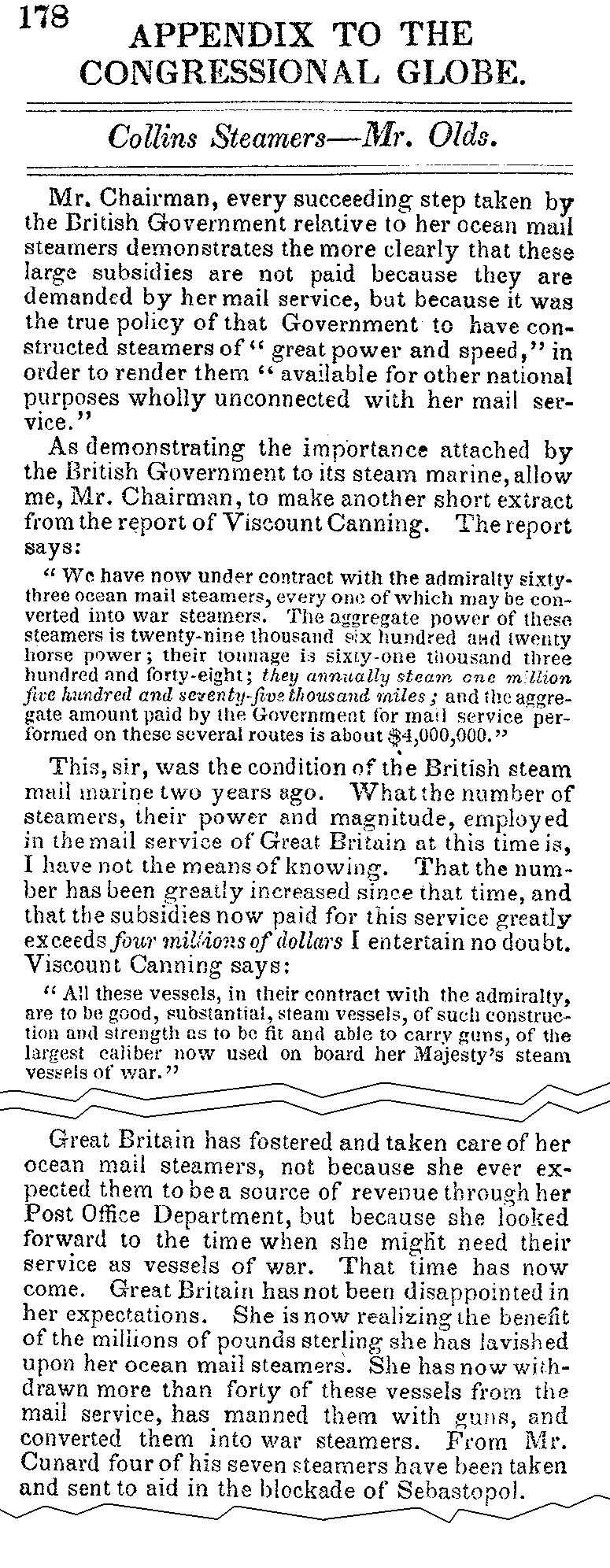
Excerpts related to the Cunard Steamship Line
from Edson Olds' speech, February 15, 1855
Appendix to the Congressional Globe, page 178 column 3
United States Congress
Source: Historical Collections for the U.S. National Digital Library
http://memory.loc.gov/ll/llcg/038/0100/01920178.tif
The Crimean War
1854-56
Sebastopol (or Sevastopol), Crimean Republic, Ukraine
The Sevastopol Federal District was established around what was once the top secret Russian naval base by the same name. Known to the west as Sebastopol, the city/base was established by Catherine the Great in the late 1700s as the home for the Imperial Russian Black Sea Fleet. It was from this port that the Russian Tsars hoped to accomplish their dream of capturing the Bosporus and Dardanelles straits and Constantinople, thereby establishing unrestricted access to warm ocean waters. In the 19th century, the British and the French supported the Ottoman Empire in order to thwart Russia's attempts at this endeavor. In the early 1850s, the allies (English, French, and Turkish forces) declared war on Russia, fought several battles in Bulgaria, notably around Varna, and interior Crimea at the Alma River, Inkerman Hills, and Traktir Bridge, and laid siege to the city of Sebastopol for nine months.
Source:
Ukrainian history: Sebastopol/Crimean War, by Roger Werner
http://www.waycool.net/sebastopol.htm
|
"From Mr. Cunard
four of his seven steamers
have been taken and sent to aid
in the blockade of Sebastopol"
(Congressman Olds' speech, 15 February 1855)
Which four Cunard ships were taken by the British Government for use during the Crimean War?
Cambria was launched on 1 August 1844 and on 4 January 1845 departed Liverpool on its maiden voyage to Halifax and Boston. From 1848 onwards it began to alternate its destination between New York and Boston. In March 1854 it was requisitioned by the British government to serve as a troop transport in the Crimean War, travelling first to Varna and then to the Crimea. After this service it was refitted and on 29 March 1856 resumed the Liverpool to Boston / New York service.
Europa was launched in September 1847 and departed Liverpool on its maiden voyage on 17 July 1848 to Halifax and Boston; the final destination on subsequent voyages varied between New York and Boston. In 1854 it became a Crimean War transport. In August 1858 it collided with another Cunard vessel, Arabia, off Cape Race and both were damaged. In February 1866 it made its last voyage from Liverpool to Boston and was sold the following year.
Niagara was launched in August 1847 and on 20 May 1848 departed Liverpool on its maiden voyage to Halifax and Boston; subsequent voyages went to either New York or Boston. In 1854 it was used as a Crimean War transport. It ran from Liverpool to Havre in 1866 but was then sold.
Note by ICS (5 July 2001):
Three of Cunard's ships, requisitioned by the British Government for military use during the Crimean War, have been identified as Cambria, Europa, and Niagara. The fourth has been more elusive.
|
Note by ICS (22 January 2002):
It now appears that seven Cunard ships were requisitioned by the British Government for military use during the Crimean War. In addition to the three named above, four others were used as Crimean War transports in 1854-1855:
Andes, Cunard's first iron-hull screw-driven ship, made its maiden voyage across the North Atlantic from Liverpool to New York, December 1852 - January 1853. In 1854 it was used as a Crimean War transport.
Arabia began its maiden voyage across the North Atlantic from Liverpool to New York on 1 January 1853. In 1854 it was used as a Crimean War transport. In 1856 Arabia returned to Cunard's transatlantic service, Liverpool - Halifax - Boston and Liverpool - New York.
Alps began its maiden voyage across the North Atlantic from Liverpool to New York on 2 February 1853. In 1854 it was used as a Crimean War transport, and then went back to Cunard's service.
Taurus was built for Cunard's Mediterranean service and began its maiden voyage from Liverpool to Constantinople on 20 April 1853. Later in 1853 Taurus travelled between Liverpool and New York, and in 1854 was used as a Crimean War transport.
|
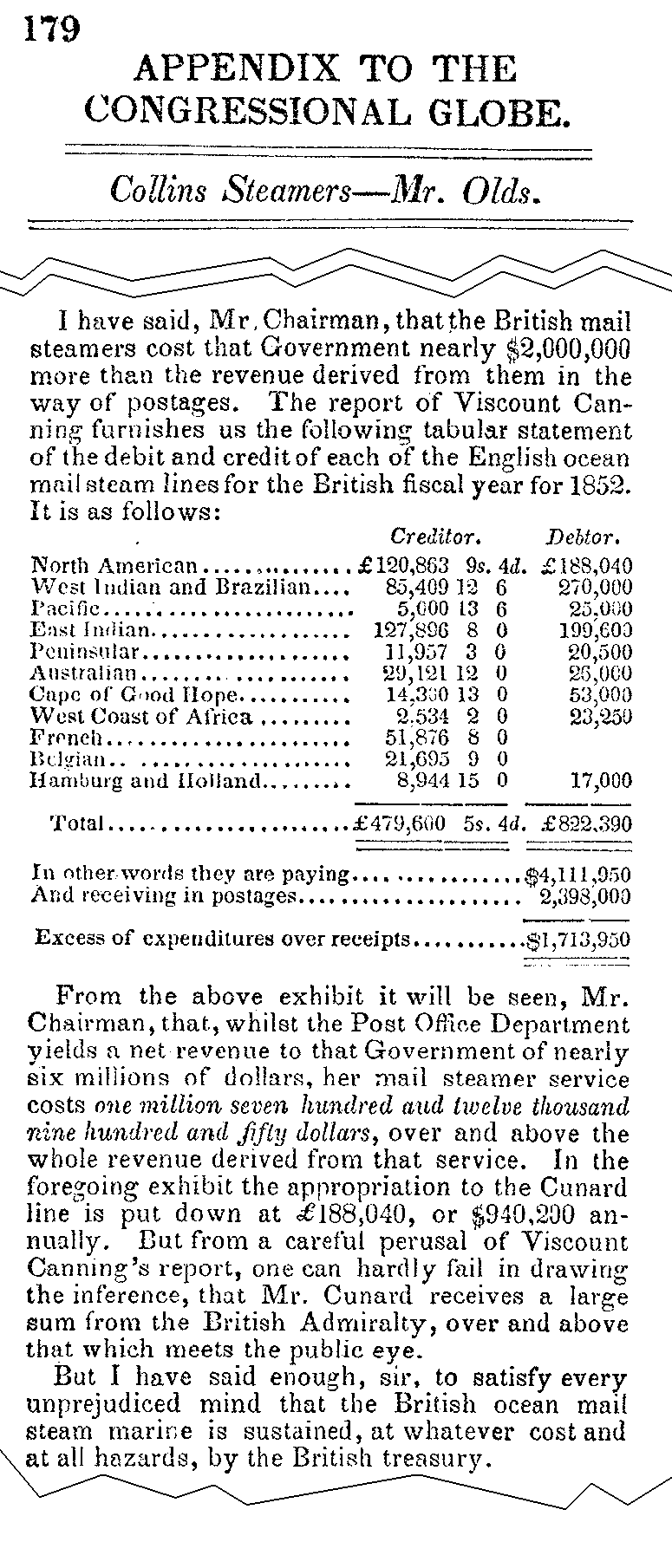
Excerpts related to the Cunard Steamship Line
from Edson Olds' speech, February 15, 1855
Appendix to the Congressional Globe, page 179 column 1
United States Congress
Source: Historical Collections for the U.S. National Digital Library
http://memory.loc.gov/ll/llcg/038/0100/01930179.tif
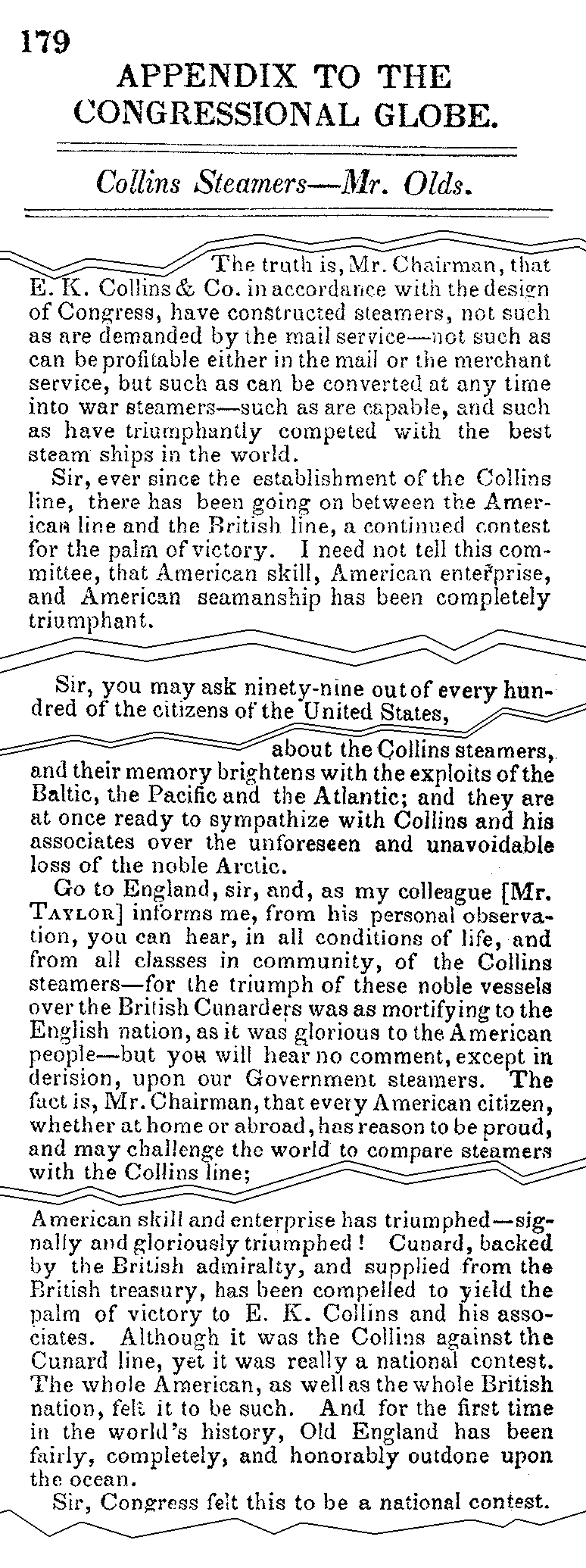
Excerpts related to the Cunard Steamship Line
from Edson Olds' speech, February 15, 1855
Appendix to the Congressional Globe, page 179 column 3
United States Congress
Source: Historical Collections for the U.S. National Digital Library
http://memory.loc.gov/ll/llcg/038/0100/01930179.tif

Excerpts related to the Cunard Steamship Line
from Edson Olds' speech, February 15, 1855
Appendix to the Congressional Globe, page 180 column 1
United States Congress
Source: Historical Collections for the U.S. National Digital Library
http://memory.loc.gov/ll/llcg/038/0100/01940180.tif

Excerpts related to the Cunard Steamship Line
from Edson Olds' speech, February 15, 1855
Appendix to the Congressional Globe, page 180 column 2
United States Congress
Source: Historical Collections for the U.S. National Digital Library
http://memory.loc.gov/ll/llcg/038/0100/01940180.tif

Excerpts related to the Cunard Steamship Line
from Edson Olds' speech, February 15, 1855
Appendix to the Congressional Globe, page 180 column 3
United States Congress
Source: Historical Collections for the U.S. National Digital Library
http://memory.loc.gov/ll/llcg/038/0100/01940180.tif
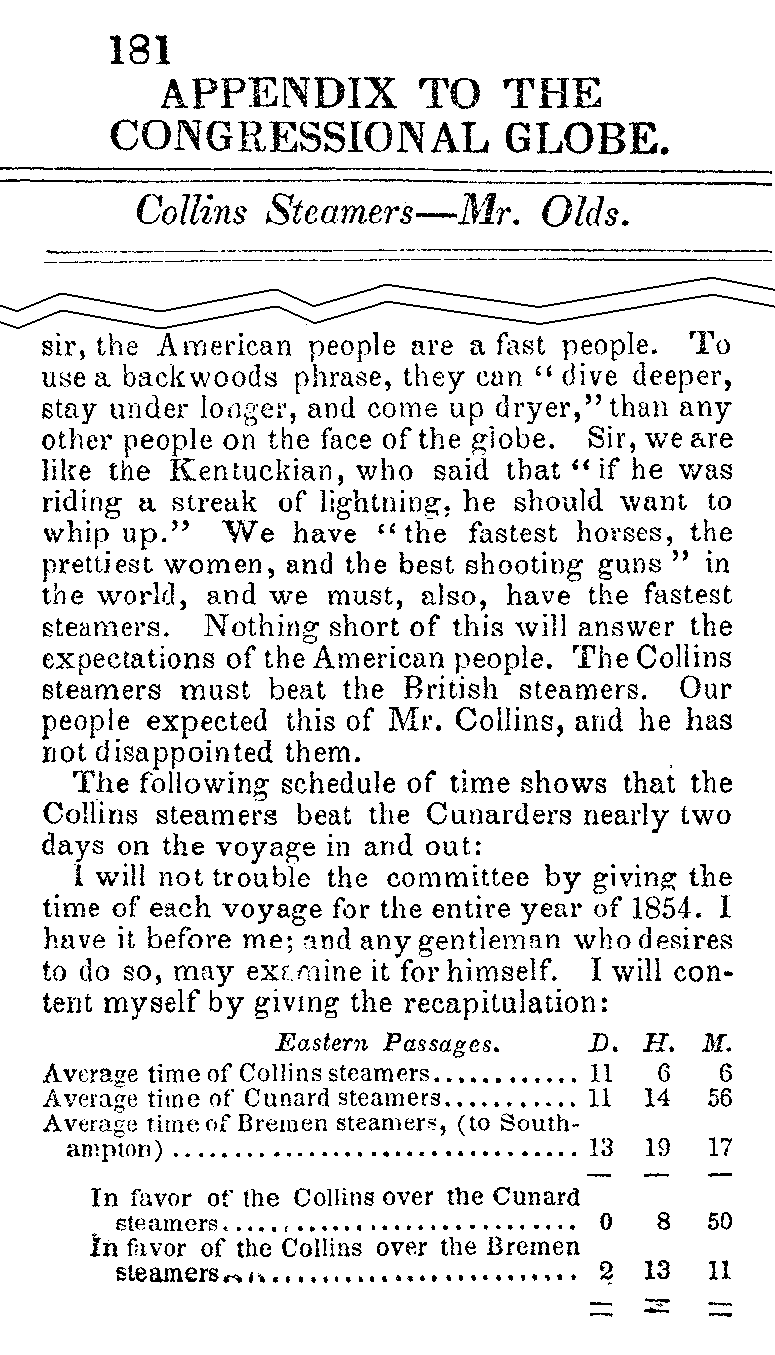
Excerpts related to the Cunard Steamship Line
from Edson Olds' speech, February 15, 1855
Appendix to the Congressional Globe, page 181 column 1
United States Congress
Source: Historical Collections for the U.S. National Digital Library
http://memory.loc.gov/ll/llcg/038/0100/01950181.tif

Excerpts related to the Cunard Steamship Line
from Edson Olds' speech, February 15, 1855
Appendix to the Congressional Globe, page 181 column 2
United States Congress
Source: Historical Collections for the U.S. National Digital Library
http://memory.loc.gov/ll/llcg/038/0100/01950181.tif

Excerpts related to the Cunard Steamship Line
from Edson Olds' speech, February 15, 1855
Appendix to the Congressional Globe, page 181 column 3
United States Congress
Source: Historical Collections for the U.S. National Digital Library
http://memory.loc.gov/ll/llcg/038/0100/01950181.tif
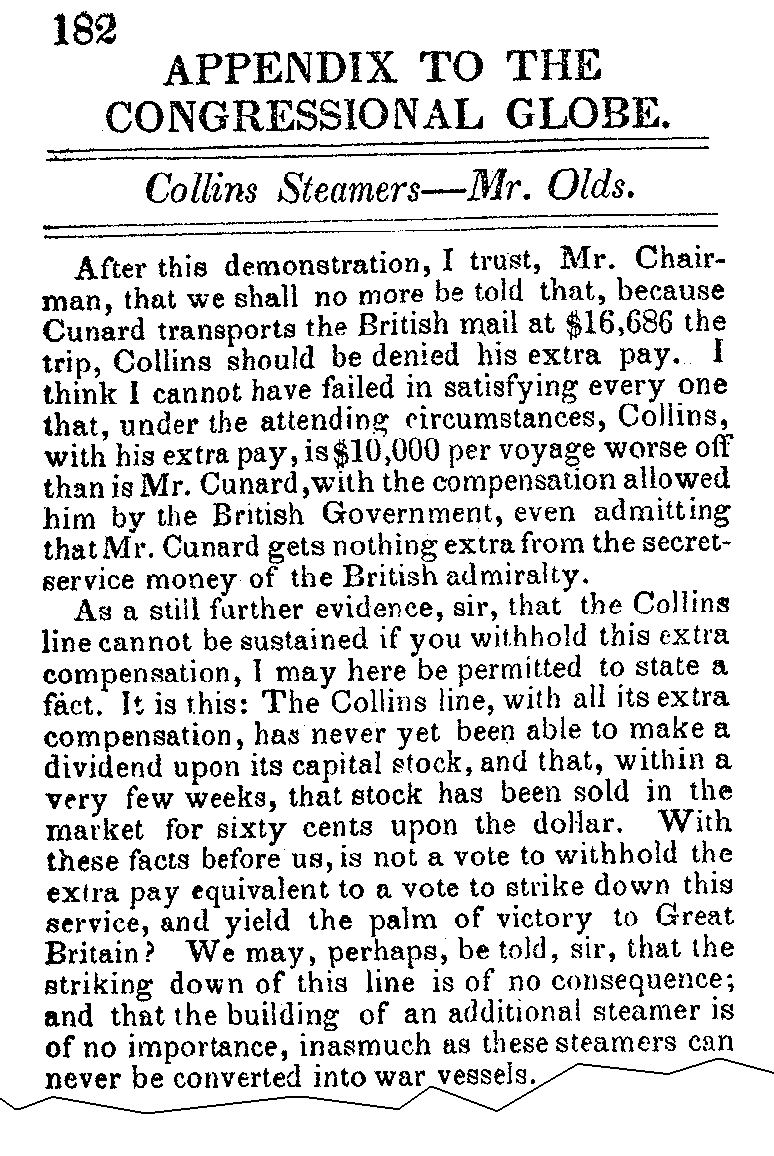
Excerpts related to the Cunard Steamship Line
from Edson Olds' speech, February 15, 1855
Appendix to the Congressional Globe, page 182 column 1
United States Congress
Source: Historical Collections for the U.S. National Digital Library
http://memory.loc.gov/ll/llcg/038/0100/01960182.tif
Edson Baldwin Olds (1802-1869): a Representative from Ohio; born in Marlboro, Vermont, June 3, 1802; moved to Ohio about 1820; member of the State house of representatives in 1842, 1843, 1845, and 1846; served in the State senate 1846-1848 and was its presiding officer in 1846 and 1847; elected as a Democrat to the 31st, 32nd, and 33rd Congresses (March 1849 to March 1855); chairman, Committee on the Post Office and Post Roads (32nd and 33rd Congresses); unsuccessful candidate for reelection in 1854 to the 34th Congress; moved to Lancaster, Ohio, in 1857; during the Civil War was arrested for disloyalty and imprisoned in Fort Lafayette in 1862; while in prison was again elected a member of the State house of representatives; after his release from prison served in the above capacity from 1862 to 1866; resumed mercantile pursuits; died in Lancaster, Ohio, January 24, 1869.
Source:
Biographical Directory of the United States Congress
http://bioguide.congress.gov/scripts/biodisplay.pl?index=O000063
The Postal Treaty with Great Britain was ratified
at Washington on the 15th of February 1849.
The Niagara — Cunard line — left Boston
with a mail under the Postal Treaty
on the 21st of February 1849
(Congressman Olds' speech, 15 February 1855)
Complete text of the 1848 Postal Convention (Treaty) between Great Britain and the United States
There shall be charged upon all letters not exceeding half an ounce 14 grams in weight, conveyed either by United States or by British packets (ships), between a port in the United States and a port in the United Kingdom, an uniform sea rate of eight pence, or sixteen cents; and such postage shall belong to the country by which the packet conveying the letters is furnished...
http://www.yale.edu/lawweb/avalon/diplomacy/britian/br1848.htm
RMS (Royal Mail Steamship) Niagara departed from Liverpool, England, at noon on Saturday, 27 January 1849, commanded by Captain Stone. On Friday, 9 February 1849, Niagara stopped as usual for a few hours at Halifax, and then continued on to Boston, arriving there on Sunday morning, 11 February. Niagara encountered much severe weather on this trip and was detained several hours by ice off Cape Sable. She brought 52 passengers to Boston.
Source: New Brunswick Courier, 17 February 1849
(A weekly newspaper published in Saint John, New Brunswick)
This was one of the regular trips under Cunard's contract with the British Admiralty. As specified by the contract, through the three months December 1848, January and February 1849, Cunard's RM ships departed Liverpool once every two weeks. From 1 March 1849, departures from Liverpool were weekly, every Saturday at noon.
As noted by Congressman Olds, Niagara's return trip departed from Boston on Wednesday, 21 February 1849.
Niagara's departure from Liverpool on Saturday, 27 January 1849, was Cunard's last westbound trip before the start of Nova Scotia's Pony Express. Cunard's next departure from Liverpool was Europa, commanded by Captain W.G. Browne, at noon Saturday, 10 February 1849. Europa arrived at Halifax at 5pm Wednesday, 21 February 1849. The first trip of the Pony Express departed Halifax on Europa's arrival and, eleven hours later, delivered the news packet to the Associated Press' specially chartered ship waiting at Victoria Beach, Annapolis County, which took the news across the Bay of Fundy to Saint John, where it was immediately telegraphed to New York.
|
1855 March 27
Gesner Patents Kerosene Process
By 1846, Abraham Gesner had succeeded in getting mineral oil from Nova Scotia coal and in using it to illuminate the Maugher's Beach lighthouse at Halifax. Seeking a better fuel oil, he experimented with distillation of various mineral petroleums. On March 27th, 1855, Gesner was awarded U.S. patents on his kerosene distillation process. He gave public demonstrations of his new lamp fuel, for which he coined the name "kerosene" — a contraction of the Greek "keroselaion," meaning wax-oil — but he could not get financial support. Gesner eventually made a fortune from development of his ideas, by founding the North American Kerosene Gas Light Company to which he assigned his patents. Commercial manufacture of kerosene under the Gesner process began in New York in 1854, and later in Boston. The raw materials were bituminous coal and oil shale. By 1859 kerosene, commonly sold as "coal oil" or "carbon oil," was available in most of the settled parts of British North America. Gesner's new fuel quickly took over most of the market for lamp oil, almost completely replacing whale oil. Abraham Gesner was a distinguished Canadian who deserves to be remembered for his contribution to marine aids to navigation.
— National Post 27 March 1999, 27 March 2000
A History of the Canadian Coast Guard and Marine Services
http://www.ccg-gcc.gc.ca/usque-ad-mare/chapter06-01_e.htm
References:
The Historical Lighting Society of Canada
http://www.historical-lighting.on.ca/
Lights of the Past: A quick survey of lights of the 19th century...
http://members.aol.com/Lumiara/homepage.html
Foulis - Gesner Conflict
http://www.saintjohn.nbcc.nb.ca/~Heritage/AlbertMines/FGConflict.htm
The Lore of Albert Mines
http://www.saintjohn.nbcc.nb.ca/~Heritage/AlbertMines/AMLore.htm
History of the Incandescent Mantle Pressure Lamp
http://homepage.ntlworld.com/munwai/history.htm
Fuel Name FAQ
http://members.iinet.net.au/~mbuckler/fuel/
How Abraham Gesner Saved the Whales At the dawn of the industrial age, whales were an important natural resource which humans had been exploiting for centuries. Whales were especially valued for their oil, which was used primarily as fuel for lamps. It was also used for heating, for lubrication, soap, paint and varnish manufacturing, and the processing of textiles and rope. The best oil was spermaceti, found only in the nose of the sperm whale. If exposed to air it would congeal, and was used for smokeless candles, regarded as the finest quality candles ever made. Whaling was a major industry in the 19th century, and the United States was the dominant whaling nation. The American whaling industry peaked in the 1850s. The reason for its decline was not because of public awareness of the evils of whaling, it was not because of consciousness-raising efforts by pioneer environmentalists, and it definitely was not because of legislation. The whales were saved because of the march of technology. The first step that led to saving the whales was made by Dr. Abraham Gesner, a Nova Scotian geologist. In 1849, he devised a method whereby kerosene could be distilled from petroleum. Petroleum had previously been considered mainly a nuisance. Earlier coal-gas methods had been used for lighting since the 1820s, but they were prohibitively expensive. Gesner's kerosene was cheap, easy to produce, could be burned in existing lamps, and did not produce an offensive odor as did most whale oil. It could be stored indefinitely, unlike whale oil, which would eventually spoil...
Kerosene: The People's Light
Excerpted from Story of a Great Monopoly
The Atlantic Monthly, March 1881
Kerosene has become, by its cheapness, the people's light the world over. In the United States we used 220,000,000 gallons of petroleum last year. It has come into such demand abroad that our exports of it increased from 79,459,000 gallons in 1868, to 417,649,000 in 1879. It goes all over Europe, and to the far East. The Oriental demand for it is increasing faster than any other. We are assured by the eloquent petroleum editor of the New York Shipping List that "it blazes across the ruins of Babylon and waste Polynesia, and Far Cathay, in Burmah, in Siam, in Java, the bronzed denizens toil and dream, smoke opium and swallow hasheesh, woo and win, love and hate, and sicken and die under the rays of this wonderful product of our fruitful caverns."
However that may be, it is statistically true that China and the East Indies took over 10,000,000 gallons in 1877, and nearly 25,000,000 gallons in 1878.
After articles of food, the United States has but one export, cotton, more valuable than petroleum. It was worth $61,789,438 in our foreign trade in 1877; $46,574,974 in 1878; and $18,546,642 in the five months ending November 30, 1879.
In the United States, in the cities as well as the country, petroleum is the general illuminator. We use more kerosene lamps than Bibles. The raw material of this world's light is produced in a territory beginning with Cattaraugus County in New York, and extending southwesterly through eight or nine counties of Pennsylvania, making a belt about one hundred and fifty miles 240 kilometres long, and twelve or fifteen miles 20 to 25 km wide, and then, with an interval, running into West Virginia, Kentucky, and Tennessee, where the yield is unimportant. The bulk of the oil comes from two counties, Cattaraugus in New York, and McKean in Pennsylvania.
There are a few places elsewhere that produce rock oil, such as the shales of England, Wales and Scotland, but the oil is so poor that American kerosene, after being carried thousands of miles, can undersell it. Very few of the forty millions of people in the United States who burn kerosene know that its production, manufacture, and export, its price at home and abroad, have been controlled for years by a single corporation, — the Standard Oil Company. This company began in a partnership, in the early years of the civil war, between Samuel Andrews and John Rockefeller in Cleveland. Rockefeller had been a bookkeeper in some interior town in Ohio, and had afterwards made a few thousand dollars by keeping a flour store in Cleveland. Andrews had been a day laborer in refineries, and so poor that his wife took in sewing. He found a way of refining by which more kerosene could be got out of a barrel of petroleum than by any other method, and set up for himself a ten-barrel still in Cleveland, by which he cleared $500 in six months. Andrews' still and Rockefeller's savings have grown into the Standard Oil Company ... It has refineries at Cleveland, Baltimore, and New York. Its own acid works, glue factories, hardware stores, and barrel shops supply it with all the accessories it needs in its business. It has bought land at Indianapolis on which to erect the largest barrel factory in the country ... It buys 30,000 to 40,000 barrels of crude oil a day, at a price fixed by itself, and makes special contracts with the railroads for the transportation of 13,000,000 to 14,000,000 barrels of oil a year ... Standard Oil produces only one fiftieth or sixtieth of our petroleum, but dictates the price of all, and refines nine tenths...
Excerpted from Story of a Great Monopoly, The Atlantic Monthly, March 1881
http://www.theatlantic.com/issues/1881mar/monopoly.htm
1855 June
Electric Telegraph Rates from Portland to Nova Scotia
Telegram Rates
1855
from Portland, Maine
|
| |
From Portland to |
First
ten
words |
Each
add'n'l
word |
| NB |
|---|
| St. Andrews |
60¢ |
3¢ |
| St. George |
| St. John |
65¢ |
3¢ |
Peticodiac Bend
(Moncton) |
75¢ |
4¢ |
| Dorchester |
80¢ |
4¢ |
| Sackville |
| NS |
|---|
| Amherst |
90¢ |
5¢ |
| Truro |
$1.05 |
6¢ |
| Pictou |
| New Glasgow |
| Pugwash |
| Tatamagouche |
| Wallace |
| Halifax |
| Antigonish |
$1.17 |
7¢ |
| Chester |
| Kentville |
| Windsor |
| Canso |
| Annapolis Royal |
$1.30 |
8¢ |
| Digby |
| Liverpool |
| Yarmouth |
$1.43 |
9¢ |
| Weymouth |
| Sydney |
| Barrington |
| Ragged Island |
Source:
1855 Maine Telegraph Company form
(see below)
|
|
The telegraph companies carefully defined a "word" to be five letters, no more and no less. The telegraph operator accepting a message for transmission would count the individual letters in the whole message and then divide by five; the result was the number of "words" for the purpose of calculating the charge. Any fractional remainder was counted as an additional word. The letter count included the address to which the telegram was to be delivered, all numbers had to be spelled out in full, and no abbreviations were allowed.
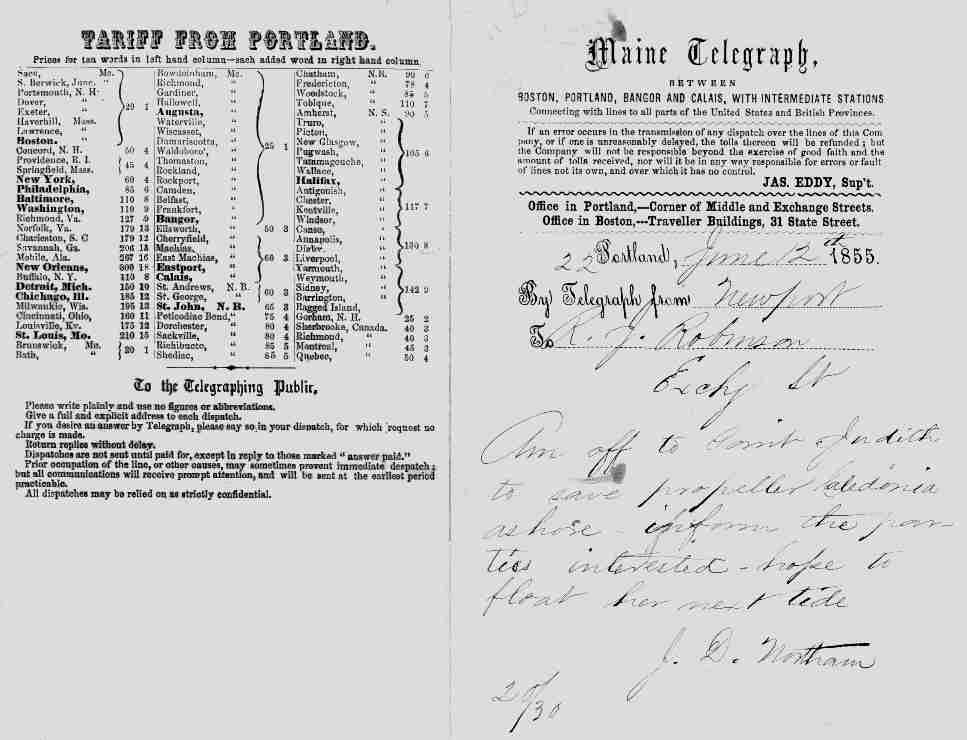
Source: http://members.aol.com/cd102/teleg82.jpg
1855 September 1
First Issue of the Yarmouth Tribune
The first issue of the Yarmouth Tribune newspaper was published this day.
1855 September 30
34 Telegraph Offices Open for Business
Nova Scotia Electric Telegraph Company
Telegraph Offices
in operation in Nova Scotia
30 September 1855
|
| Annapolis |
Middleton |
| Antigonish |
New Glasgow |
| Arichat |
Pictou |
| Barrington |
Port Hood |
| Bridgewater |
Pugwash |
| Bridgetown |
Ragged Islands |
| Canso East |
Sackville |
| Canso West |
Shelburne |
| Cape Canso |
Sydney |
| Chester |
Tatamagouche |
| Digby |
Truro |
| Guysborough |
Wallace |
| Halifax |
Weymouth |
| Hantsport |
Wilmot |
| Kentville |
Windsor |
| Liverpool |
Wolfville |
| Lunenburg |
Yarmouth |
Source: 1855 Annual Report of the
Nova Scotia Electric Telegraph Company
dated in Halifax on 9th January 1856 and
published as Appendix No. 6, pages 67-72
of Journal and Proceedings of the House
of Assembly of Nova Scotia, Session 1856
CIHM: 9_00946_107
|
1856
Telegraph Cable Laid,
Newfoundland to Cape Breton
As part of the electric telegraph line it was building between St. John's and New York City, the New York, Newfoundland, and London Telegraph Company laid a submarine (underwater) telegraph cable across Cabot Strait between Cape Breton and Newfoundland.
1856 November 9
Electric Telegraph in Operation
St. John's to New York
New York, Newfoundland, and London Telegraph Company
Nova Scotia Electric Telegraph Company
For the first time, messages were transmitted by electric telegraph all the way between St. John's, Newfoundland, and New York City, over a line built across Newfoundland by the New York, Newfoundland, and London Telegraph Company. Over land, this line was a single number nine iron wire, supported on poles (about 32 poles to the mile 20 poles per kilometre). Between Newfoundland and Nova Scotia, the telegraph circuit was connected through an underwater cable laid on the bottom of Cabot Strait in the summer of 1856.
This telegraph line across Nova Scotia ran through Aspy Bay (Cape North), Ingonish, Baddeck, Port Hastings, Antigonish, New Glasgow, and Amherst.
Nova Scotia Electric Telegraph Company
http://epe.lac-bac.gc.ca/100/205/300/nova_scotias_electronic_attic/07-04-09/www.littletechshoppe.com/ns1625telegr03.html
New York, Newfoundland, and London Telegraph Company
http://epe.lac-bac.gc.ca/100/205/300/nova_scotias_electronic_attic/07-04-09/www.littletechshoppe.com/ns1625telegraph02.html
1856 December
Newfoundland and Nova Scotia Wired Together
Submarine Telegraphs
Scientific American magazine
There is now a telegraph wire from Dover to Calais under the British Channel. There is a wire from Ostend to Dover under the German Ocean, Dublin and Liverpool are connected by a wire under the Irish Sea. Vienna and Sebastopol are linked by a wire under an arm of the Black Sea. The Ionian Isles are next year to be wired fast to Greece. Algeria is to be fastened to France, Malta to England, and Egypt to Constantinople. New Foundland is connected to Nova Scotia by a wire, and in 1867 the London Telegraph operator will hold in his hand wires running to the four quarters of the globe, as easily as a coachman gathers up the reins of a four-in-hand.
[Scientific American, New York, 20 December 1856]
1857
First "Piggy-Back" Service
"Man, horse, and wagon, (not to exceed 600 pounds 270 kg) would be carried from Mt. Uniacke to Halifax for fifty cents" on railway flat cars. "As many as fourteen cars of wagons have been conveyed at one time to Halifax." This service was used mostly to carry farm produce from the Annapolis Valley to Halifax. At this time the railway ended at Mount Uniacke.
[The quotes are from History of Railroading in the Annapolis Valley by Conductor W.W. Clark, excerpts published in the special Railway Edition of The Sunday Leader, Halifax, 4 November 1923.]
1857 December 30
First Train to Windsor
The contractor building the railway from Windsor Junction to Windsor (the track known ever since as the "Windsor Branch") ran a locomotive and one flat car from Halifax all the way to Windsor on this day. The track was not yet adequately ballasted and levelled, but the rails were continuous along the entire distance, and, with care, the little train reached its destination, thus demonstrating that the work had reached an advanced stage, and the line was close to being finished and ready for regular traffic.
1857 March 3
U.S. Congress Authorizes Atlantic Telegraph Contract
New York, Newfoundland, and London Telegraph Company

United States Congress authorizes Atlantic Telegraph contract, March 3, 1857
Chapter XCV — An Act to expedite Telegraphic Communication
for the Uses of the Government in its Foreign Intercourse
March 3, 1857
Be it enacted by the Senate and House of Representatives of the United States of America in Congress assembled, That the Secretary of State, in the discretion, and under the
 direction of the President of the United States, may contract with any competent person, persons, or association, for the aid of the United States, by furnishing not exceeding two ships in laying down a submarine cable, to connect existing telegraphs between the coast of Newfoundland and the coast of Ireland, and for the use of such submarine communication when established by the government of the United States, on such terms and conditions as shall seem to the President just and reasonable, not exceeding seventy thousand dollars per annum until the nett profits of such person, or persons, or association, shall be equal to a dividend of six per cent. per annum, and then not exceeding fifty thousand dollars per annum for twenty-five years:
direction of the President of the United States, may contract with any competent person, persons, or association, for the aid of the United States, by furnishing not exceeding two ships in laying down a submarine cable, to connect existing telegraphs between the coast of Newfoundland and the coast of Ireland, and for the use of such submarine communication when established by the government of the United States, on such terms and conditions as shall seem to the President just and reasonable, not exceeding seventy thousand dollars per annum until the nett profits of such person, or persons, or association, shall be equal to a dividend of six per cent. per annum, and then not exceeding fifty thousand dollars per annum for twenty-five years:
 Provided, that the government of Great Britain shall, before or at the same time, enter into a like contract for those purposes with the same person, persons, or association, and upon terms of exact equality with those stipulated by the United States: And provided, That the tariff of prices for the use of such submarine communication by the public shall be fixed by the Secretary of the Treasury of the United States and the government of Great Britain, or its authorized agent: Provided further, That the United States and the citizens thereof shall enjoy the use of the said submarine telegraph communication for all time on the same terms and conditions which shall be stipulated in favor of the government of Great Britain, and the subjects thereof, recognizing equality of rights among the citizens of the United States in the use of said submarine communication and the lines of telegraph which may at any time connect with the same at its terminus on the coast of New Foundland and in the United States, in any contract so to be entered into by such person, persons, or association, with that government:
Provided, that the government of Great Britain shall, before or at the same time, enter into a like contract for those purposes with the same person, persons, or association, and upon terms of exact equality with those stipulated by the United States: And provided, That the tariff of prices for the use of such submarine communication by the public shall be fixed by the Secretary of the Treasury of the United States and the government of Great Britain, or its authorized agent: Provided further, That the United States and the citizens thereof shall enjoy the use of the said submarine telegraph communication for all time on the same terms and conditions which shall be stipulated in favor of the government of Great Britain, and the subjects thereof, recognizing equality of rights among the citizens of the United States in the use of said submarine communication and the lines of telegraph which may at any time connect with the same at its terminus on the coast of New Foundland and in the United States, in any contract so to be entered into by such person, persons, or association, with that government:
 Provided further, That the contract to be made by the British government shall not be different from that already proposed by that government to the New York, Newfoundland, and London Telegraph Company except such provisions as may be necessary to secure to each government the transmission of its own messages by its own agents: And provided further, That it shall be in the power of Congress, after ten years, to terminate said contract upon giving one year's notice to the parties to such contract.
Provided further, That the contract to be made by the British government shall not be different from that already proposed by that government to the New York, Newfoundland, and London Telegraph Company except such provisions as may be necessary to secure to each government the transmission of its own messages by its own agents: And provided further, That it shall be in the power of Congress, after ten years, to terminate said contract upon giving one year's notice to the parties to such contract.
Approved March 3, 1857
Source:
Statutes at Large and Treaties, volume XI, pages 187-188
Little, Brown and Company, Boston, 1859
Historical Collections for the U.S. National Digital Library
page 187: http://memory.loc.gov/ll/llsl/011/0200/02090187.tif
page 188: http://memory.loc.gov/ll/llsl/011/0200/02100188.tif
References:
...The average performance of the Morse instruments is said to be from 8,000 to 9,000 letters per hour, and the usual charge is twenty-five cents for ten words or less, for the distance of one hundred miles...
BR> http://www.atlantic-cable.com/Shaffner/35th-congress.htm
Anglo-American Telegraph Company records 1866-1947
http://americanhistory.si.edu/archives/d8073.htm
[Note: The repeated references to "F.N. Crisborne" are mistakes — the correct spelling is F.N. Gisborne.]
...1866 telegraph tariff rates were very expensive: cable charges between America and Great Britain were $100 or 20 pounds sterling for messages of 20 words or less, including address, date, and signature. Every additional word, not exceeding five letters, cost 20 shillings. Code or cipher messages charged double. And all messages had to be paid in gold before transmission...
http://www.elxsi.de/cryptome.org/us-cable1.htm
1858
Chronology of Development of
Electric Telegraph Lines in Nova Scotia
Nova Scotian Telegraph
1849 - 1858
|
| |
Miles |
km |
Built |
| Halifax to New Brunswick border |
130 |
209 |
1849 |
| Truro to Pictou |
40 |
64 |
1850 |
| Halifax to Liverpool |
102 |
164 |
1851 |
| Halifax to Yarmouth (via Windsor) |
224 |
361 |
1852 |
| Pictou to Sydney, C.B. |
195 |
314 |
1852 |
| Pictou to Amherst (via Pugwash) |
80 |
129 |
1853 |
| Liverpool to Barrington |
62 |
100 |
1853 |
| Halifax to Truro (second wire) |
64 |
103 |
1853 |
| Barrington to Yarmouth |
45 |
72 |
1854 |
| Antigonishe to Cape Canso |
67 |
108 |
1854 |
| St. Peters, C.B. to Arichat, C.B. (about) |
20 |
32 |
1854 |
Plaister Cove to Port Hood
(Plaister Cove is now known as Port Hastings) |
28 |
45 |
1855 |
| Wolfville to Canning |
9 |
14 |
1858 |
| Total |
1,066 |
1,716 |
|
All these telegraph lines in Nova Scotia are of number nine plain (ungalvanized) iron wire, except the second wire between Halifax and Truro which is number nine galvanized iron. The poles are spruce and tamarack, about 35 to 40 to the mile about 22 to 25 to the kilometre. The lines are worked on the Morse principle, and nearly everything is taken by sound.
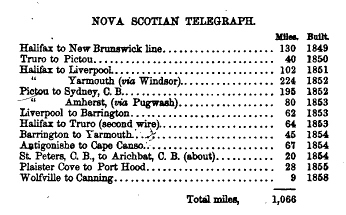
Source: Page 267 Eighty Years' Progress of British North America: showing the development of its natural resources by the unbounded energy and enterprise of its inhabitants: giving, in a historical form, the improvements made in agriculture, commerce and trade, modes of travel and transportation, mining, and educational interests, e&c., e&c., with a large amount of statistical information from the best and latest authorities (book) by Henry Youle Hind, published in Toronto by L. Stebbins and in London, England, by Sampson Low, Son & Marston, 1863.
Early Canadiana Online (ECO) project
http://www.canadiana.org/
CIHM 64288
Canadian Institute for Historical Microreproductions
http://www.nlc-bnc.ca/cihm/
"nearly everything is taken by sound"
In the very early days of the electric telegraph, the equipment was designed
to deliver the message at the destination in the form of a squiggly line drawn
by a mechanical pen on a paper tape — the line appearing along one side of
the tape when there was no electric current in the telegraph circuit, moving
across the tape when an electric current was supplied by the transmitter,
and returning when the current disappeared — while the tape was pulled
along at a steady speed by a clockwork mechanism.
A shorter deviation indicated a dot, and a longer deviation a dash.
After the complete message had been recorded on the paper tape, someone
would tear off the tape, lay it on a table, and "read" it — scanning the
squiggles in sequence from beginning to end, to decide what characters were
represented and marking each one directly on the tape. Then the message
would be copied from the marked tape by hand onto paper, usually a printed
telegraph form, which was then delivered to the addressee.
The tape-marking machine was very simple. The mechanical pen was mounted
on a pivoted iron arm, which was placed close to a magnet connected to the
telegraph circuit. The current in the telegraph line activated the magnet,
which pulled the arm and pen and changed the position of the line on the tape.
The marking machine had adjustable stops to control the movement of the arm.
As the dots and dashes came through the circuit, the arm would move back
and forth between the stops, making a clicking sound each time it moved.
After a few months, some operators found that they could tell the characters
from the clicking sound, without looking at the tape. They could write the
message directly on the printed form, just by listening to the clicking of the
marking arm. This development was a complete surprise to everyone.
Nobody had anticipated that the message could be received just by listening
to the clicking sound.
This ability to write down the message directly from the sounder was a
significant improvement in telegraph operations, and was quickly adopted
in telegraph offices everywhere. However, this method meant that telegraph
operators had to develop a new skill which required special training. This 1863
report that, in telegraph offices in Nova Scotia, "nearly everything is taken
by sound" means that our telegraph system was using up-to-date methods.
The tape-marker machines were kept, however, for occasional use for special
messages where a direct paper record was considered to be desirable;
this is the reason that "nearly everything" (but not everything) was taken
by sound.
Note by ICS, 24 May 2002
|
1858 June 3
Official Opening of the Railway to Windsor
On this day, Thursday, a train departed Richmond (Halifax) at 7:30am, crowded with passengers. This was the first train for public use, on the new Nova Scotia Railway line between Halifax and Windsor.
The train arrived on schedule at Windsor at 11:00am, where almost the entire population was gathered at the station to see this important event. The train departed Windsor on the return trip at 3:00pm, and arrived at Richmond at 6:00.
To celebrate the opening of the Windsor Branch, the following Tuesday, June 8th, was declared a public holiday in Halifax by the Lieutenant Governor, His Excellency G.A.C. Phipps, the Earl of Mulgrave; all shops and offices were closed to enable the population to celebrate.
As Marguerite Woodworth described it (quoting from a contemporary source), "At 5:30am the people were aroused by a "merry peal from all church bells"; at 6:30am any laggards were reminded of the occasion by a royal salute of 109 guns by the Royal Artillery from the Grand Parade; at 10:00am there was a "Grand review of the Troops, ending with a Sham Fight" on the Common; a yacht race took place at 1:00pm, and the ceremonies ended with a grand ball at Government House.
During the remainder of 1858, the trains between Halifax and Windsor carried 11,324 first class and 6,927 second class passengers; passenger revenue was £7,584 17s 1p. The second class fare was two cents per mile. Income from freight (which included 189,465 board feet of lumber) totalled £2,550 5s 11p, and horse and wagon traffic provided revenue of £1,466 5s 4p.
[Excerpted from History of the Dominion Atlantic Railway, by Marguerite Woodworth, 1936.]
Note by ICS, 7 May 2002:
In her book History of the Dominion Atlantic Railway, Marguerite Woodworth states that as part of the celebration of the opening of the Windsor Branch, Tuesday, June 8th, 1858, was declared a public holiday in Halifax by "the Lieutenant Governor, His Excellency Sir Gaspard le Marchant, the Earl of Mulgrave; all shops and offices were closed to enable the population to celebrate"...
However, Mr. Jay Underwood has helpfully brought to my attention that Sir Gaspard le Marchant and the Earl of Mulgrave were two different people.
There were two Nova Scotia Lieutenant Governors during 1858:
Sir John Gaspard Le Marchant: 5 Aug 1852 - 15 Feb 1858
George Augustus Constantine Phipps, Earl of Mulgrave: 15 Feb 1858 - 17 Sep 1863
Thus G.A.C. Phipps was the Lieutenant Governor who presided over the official celebration of the opening of the Halifax to Windsor railway in June 1858.
|
189,465 board feet = 15,789 cubic feet
= 447.1 cubic metres
|
1858 August 16
Queen Victoria Sends Telegram
to President Buchanan
Across Nova Scotia by Overhead Wire
The first official (test messages had been exchanged for ten days) message sent across the Atlantic Ocean at the speed of electricity was from Queen Victoria, in London, to President James Buchanan, in Washington, USA.
This message was carried by a combination of methods: across the Atlantic to Newfoundland by submarine (underwater) cable, across Newfoundland by an overhead wire supported on poles, across Cabot Strait by submarine cable to Aspy Bay (Dingwall), Cape Breton, and by an overhead wire across Nova Scotia, New Brunswick, and Maine, to Boston and New York.
"At the speed of electricity" has to be qualified — the speed of transmission of a message (number of characters transmitted per minute) varies inversely as the square of the cable's length; a cable twice as long needs four times as much time to transmit a given message. The transatlantic cable laid in 1858 between Ireland and Newfoundland was very long. The Queen's message to Washington commenced transmission at 10:50am on August 16, and was completed at 4:30am the next day, taking 17 hours and 40 minutes. It contained 99 words consisting of 509 letters, which averaged about two minutes and five seconds for each letter. And that was just to reach Newfoundland; it still had to reach Buchanan.
The cable operated for less than a month. For the first few messages, 600 volts was applied at the sending end, but the speed (two minutes per letter) was very slow, and the sending-end battery was boosted to 2000 volts in an effort to increase the working speed. The speed was increased, but the higher voltage overstressed the cable insulation, it began failing in a few hours and went competely dead on 3 September 1858. It was to be six years before telegraph messages were again sent across the Atlantic.
Great Benefit from Telegraph Communication
The British government had a stark lesson in how useful the telegraph could be in ruling its scattered empire. One of the messages passing through the 1858 cable told the 62nd Regiment in Nova Scotia that they were no longer needed to help subdue the Indian mutiny, countermanding previous instructions to embark for London. This nine-word communication alone, it was said, had saved the British government £50,000, the expense of a needless mobilisation.
Source:
The Transatlantic Telegraph Cable, by Gillian Cookson, History Today, March 2000
http://www.findarticles.com/cf_1/m1373/3_50/60081469/print.jhtml
http://www.findarticles.com/cf_1/m1373/3_50/60081469/p1/article.jhtml
1858 December 15
Official Opening of the Railway to Truro
The new railway line between Halifax and Truro was officially opened for traffic on this day.
1859 October
Margaretsville Lighthouse
In 1859, the thriving village of Margaretsville, in Annapolis County about 14 km northwest of Middleton, decided that a lighthouse was a necessity to navigation for vessels plying the water of the Bay of Fundy in ever increasing numbers. Under the supervision of William Earley, it was built on a point south of the breakwater, on the edge of the Bay of Fundy at latitude 45°03' N and longitude 65°04' W. It is twenty feet six metres high, painted white with black bands. It was built by Sir Brenton Haliburton, and the light, located thirty feet nine metres above the water, was installed in October 1859.
The year 1859 was a good one for lighthouse building. The Margaretsville Lighthouse was one of the first along the Nova Scotia shore of the Bay of Fundy, and was completed at the same time as several others. Before that time there were only about six lighthouses in operation on the Fundy, and they were on the New Brunswick side.
Willian Earley became the first lightkeeper and remained in the job until 1887. The light was produced by burning kerosene oil in eight lamps surrounded by red glass globes, with brass reflectors. One of the lightkeeper's most important duties each day was to clean and polish the reflectors and lamp globes, fill the lamps with oil, and inspect and trim the wicks.
John Earley replaced his father as lightkeeper, and held that position until 1907. While John was there, the second floor of the lighthouse was converted to include living quarters. He was able to maintain a residence there during bad weather. After John Earley's death, his widow, Ruth Earley, became keeper from 1907 to 1910. She holds the distinction of being the only woman to be lightkeeper at Margaretsville. The old lantern was removed and replaced with a new cast iron top was installed on the tower during her term. That top is still in place.
After Mrs. Earley, Captain W. Wesley Goucher kept the light until 1912. The light was fueled by kerosene oil. According to lightkeeper Joseph L. "Dody" Cleveland, who kept the light from 1912 to 1937, the light burned about twelve gallons about 55 litres of kerosene oil each month in the wintertime, and about seven gallons about 32 litres in the summertime when the hours of darkness were shorter. All lighthouse lights were lit just before sunset and extinguished at dawn.
Lehan H. Cleveland followed Dody in the keeper's job, and stayed until 1940. He was replaced by Captain Ray Hall who worked there until 1956; he was replaced by Gordon Aldred, the last of the Margaretsville lightkeepers. The light was automated in 1963, ending the need for a lightkeeper in attendance.
Thanks to the efforts of Viva Moody of Margaretsville and Maybelle Earley Warren of the USA, a plaque was placed on the lighthouse by the Canadian Coast Guard in 1985. It commemorates William Earley's role as lightkeeper and an important figure in local history.
[Down Memory Lane, in the Middleton Mirror-Examiner, 9 & 16 August 2000]
References:
Lighthouses of Nova Scotia
Nova Scotia Lighthouse Preservation Society website
http://www.ednet.ns.ca/educ/heritage/nslps/
Margaretsville Lighthouse
http://www.ednet.ns.ca/educ/heritage/nslps/margaretsville.htm
http://www.lhdigest.com/database/uniquelighthouse.cfm?value=1001
http://wvda.com/film/p_lighthouses.html
A Brief History of Canadian Lighthouses
http://members.aol.com/stiffcrust/pharos/
1893
Margaretville Light House, located on extremity of point, south shore, at latitude 45°02'57" N and longitude 65°04' W, two fixed red catoptric lights, 30 and 27 feet 9.1 and 8.2 metres high, visible 8 miles 13 km, square building horizontal white and black stripes, height 22 feet 6.7 m. Visible from W.S.W. round N. to E.N.E.
Source:
Light Houses on the Coasts of Nova Scotia and New Brunswick
Pages 168-188, Belcher's Farmer's Almaanack, 1893
Catoptric Light
Light that is directed or focused by means of curved reflective surfaces.
The catoptric system involves using a parabolic reflector behind the light. The catoptric system is similar to that used in modern flashlights; if you take one apart you'll see a parabolic reflector in which the lightbulb filament is placed at the focal point of the parabola. This system was first employed in lighthouses in the mid 1700s (1763, at Mersey, England, was the first). When a flame is used as the light source — candles, oil lamps, acetylene... — the flame is placed at the parabolic focus.
Source:
http://www.tesarta.com/www/resources/library/lighthouse.html
Wayback Machine
Wayback Machine
http://web.archive.org/index.html
"Use the Wayback Machine to view web sites from the past."
Archive of This Document:
History of Nova Scotia, Chapter 9
The Wayback Machine has copies of this webpage from the early days:
Archived: 2000 August 15
http://web.archive.org/web/20000815195255/http://www.alts.net/ns1625/nshist09.html
Archived: 2000 December 6
http://web.archive.org/web/20001206081500/http://epe.lac-bac.gc.ca/100/205/300/nova_scotias_electronic_attic/07-04-09/www.littletechshoppe.com/ns1625nshist09.html
Archived: 2001 February 8
http://web.archive.org/web/20010208132736/http://www.alts.net/ns1625/nshist09.html
Archived: 2001 April 19
http://web.archive.org/web/20010419135245/http://www.alts.net/ns1625/nshist09.html
Archived: 2001 August 16
http://web.archive.org/web/20010816212740/http://epe.lac-bac.gc.ca/100/205/300/nova_scotias_electronic_attic/07-04-09/www.littletechshoppe.com/ns1625nshist09.html
Archived: 2001 November 16
http://web.archive.org/web/20011116051114/http://www.alts.net/ns1625/nshist09.html
|
Index with links to the other chapters
Go To: History of Railway Companies in Nova Scotia
http://epe.lac-bac.gc.ca/100/205/300/nova_scotias_electronic_attic/07-04-09/www.littletechshoppe.com/ns1625railways.html
Go To: History of Telegraph and Telephone Companies in Nova Scotia
http://epe.lac-bac.gc.ca/100/205/300/nova_scotias_electronic_attic/07-04-09/www.littletechshoppe.com/ns1625telephone.html
Go To: History of Automobiles in Nova Scotia
http://epe.lac-bac.gc.ca/100/205/300/nova_scotias_electronic_attic/07-04-09/www.littletechshoppe.com/ns1625automobiles.html
Go To: History of Electric Power Companies in Nova Scotia
http://epe.lac-bac.gc.ca/100/205/300/nova_scotias_electronic_attic/07-04-09/www.littletechshoppe.com/ns1625electric.html
Go To: Photographs of War Memorials and Historic Monuments in Nova Scotia
http://ns1763.ca/remem/plaques.html
Go To: Index to other online Nova Scotia History
http://epe.lac-bac.gc.ca/100/205/300/nova_scotias_electronic_attic/07-04-09/www.littletechshoppe.com/ns1625histindx.html
Go To: Home Page
http://epe.lac-bac.gc.ca/100/205/300/nova_scotias_electronic_attic/07-04-09/www.littletechshoppe.com/ns1625index.html

W3C HTML Validation Service
http://validator.w3.org/

W3C CSS Validation Service
http://jigsaw.w3.org/css-validator/
Latest content revision: 2003 September 25





























 Provided, that the government of Great Britain shall, before or at the same time, enter into a like contract for those purposes with the same person, persons, or association, and upon terms of exact equality with those stipulated by the United States: And provided, That the tariff of prices for the use of such submarine communication by the public shall be fixed by the Secretary of the Treasury of the United States and the government of Great Britain, or its authorized agent: Provided further, That the United States and the citizens thereof shall enjoy the use of the said submarine telegraph communication for all time on the same terms and conditions which shall be stipulated in favor of the government of Great Britain, and the subjects thereof, recognizing equality of rights among the citizens of the United States in the use of said submarine communication and the lines of telegraph which may at any time connect with the same at its terminus on the coast of New Foundland and in the United States, in any contract so to be entered into by such person, persons, or association, with that government:
Provided, that the government of Great Britain shall, before or at the same time, enter into a like contract for those purposes with the same person, persons, or association, and upon terms of exact equality with those stipulated by the United States: And provided, That the tariff of prices for the use of such submarine communication by the public shall be fixed by the Secretary of the Treasury of the United States and the government of Great Britain, or its authorized agent: Provided further, That the United States and the citizens thereof shall enjoy the use of the said submarine telegraph communication for all time on the same terms and conditions which shall be stipulated in favor of the government of Great Britain, and the subjects thereof, recognizing equality of rights among the citizens of the United States in the use of said submarine communication and the lines of telegraph which may at any time connect with the same at its terminus on the coast of New Foundland and in the United States, in any contract so to be entered into by such person, persons, or association, with that government:
 Provided further, That the contract to be made by the British government shall not be different from that already proposed by that government to the New York, Newfoundland, and London Telegraph Company except such provisions as may be necessary to secure to each government the transmission of its own messages by its own agents: And provided further, That it shall be in the power of Congress, after ten years, to terminate said contract upon giving one year's notice to the parties to such contract.
Provided further, That the contract to be made by the British government shall not be different from that already proposed by that government to the New York, Newfoundland, and London Telegraph Company except such provisions as may be necessary to secure to each government the transmission of its own messages by its own agents: And provided further, That it shall be in the power of Congress, after ten years, to terminate said contract upon giving one year's notice to the parties to such contract.

![]()
![]()